

PRO TIPS FOR WILDLIFE PHOTOS Forge a bond between viewer and subject with Tamron’s suite of wildlife-friendly lenses. Cover image by David Akoubian with the Tamron 150-500mm F/5-6.7 Di III VC VXD MAGAZINE I ssue 14 · Fall 2022 A FAMILY AFFAIR Marcie Reif gathers groups with the new 20-40mm F/2.8 Di III VXD. NEW 70-300MM RXD Meet Tamron’s first lens for the Nikon Z-Mount mirrorless system.

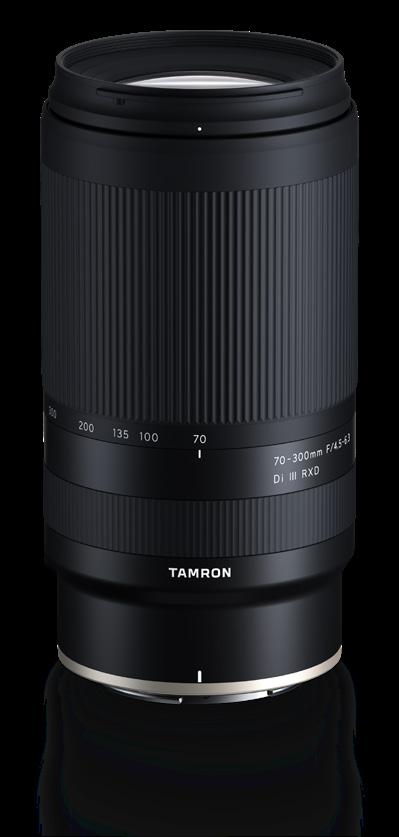
www.tamron-americas.com
Get 300mm telephoto range like an expert ULTRA-TELEPHOTO ZOOM LENS for Nikon Z-Mount Mirrorless Cameras [ model A047] NIKON Z-MOUNT70-300mm F/4.5-6.3 Di III RXD ONLY AVAILABLE AT YOUR AUTHORIZED TAMRON AMERICAS RETAILER 70-300mm (254mm), F/6.0, 1/100 sec., ISO 640
© Yukie Hayashi
New 70-300mm Nikon Z-Mount
New 150-500mm FUJIFILM X-Mount
New 20-40mm F2.8 for Sony E-Mount
PRACTICE Ken Hubbard in the Canadian Rockies with the new 20-40mm
Dear Readers,
Another holiday season is upon us and we hope this year will find you gathering with friends and family for a special meal and cherished time together. Be sure to grab your camera and document everything from the food and decorations, to the beauty indoors and out. And don’t forget the people! This issue will provide lots of tips and inspiration for capturing memorable portraits of your loved ones. We’ve introduced several new lenses since our last issue, most notable is our first lens for Nikon Z-Mount! The 70-300mm F/4.5-6.3 Di III RXD (Model A047) is the most lightweight and compact zoom in its class for mirrorless cameras. And it’s perfect for both Sony E and Nikon Z crop sensor cameras, providing you with an ultra tele reach of 105-450mm! Another exciting and disrupting lens is the new 20-40mm F/2.8 Di III VXD that breaks the conventional notion of a standard zoom. See how Ken Hubbard put the lens to use to capture dramatic scenery (page 12) while Marcie Reif captured the smiles of her subjects with the same lens (page 36). Ian Plant’s excursion to the cypress bayou of Texas and Louisiana (page 32) will have you packing your Tamron lenses and headed off to this surreal location to capture your own stunning images. And of course, there is a wildlife photographer in all of us, whether the subject skitters across your backyard or roams the plains. Check out the tips from the pros in this issue’s special section (page 16) on photographing wildlife. Then break out your Tamron zoom and show us the wildlife you’ve photographed using the hashtag #withmytamron.
And lastly, you may have noticed Tamron USA is now Tamron Americas! Be sure to bookmark Facebook, Instagram and Twitter @tamronamericas to keep up with all the latest Tamron news and photo tips, and to see inspirational images reposted from users like you!


Enjoy the coming winter season, stay healthy and take lots of photos. See you in the Spring.
Sincerely,
Stacie Errera Vice President, Marketing & Communications

Tamron goes Tinseltown with Bradley Everett Young
Lisa Langell with her 50-400mm VC VXD lens
Ian Plant captures the Southern cypress wetlands
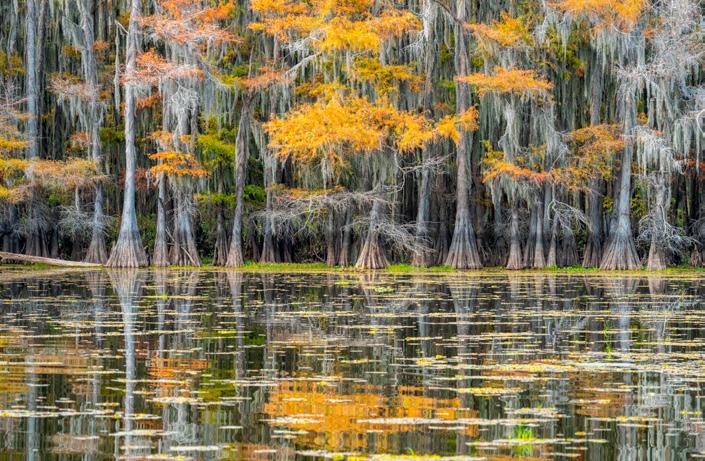
Marcie Reif shoots group portraits with her new standard zoom
Julien Jarry shares passion projects created with Tamron lenses
MY PROJECT Noah H. F. Bullock explores Greece with his 17-70mm zoom
PARTING SHOT Masaki Kadono’s “Fox Against the Blue Sky”
Tamron Magazine 3 CONTENTS 4 NEWS
6
Check us out on YouTube and subscribe to our eNewsletter
TOP FEATURES
8
TOP FEATURES
10
TOP FEATURES
12
16 SPECIAL Pro
22
24
tips for wildlife photos
HIGHLIGHT Thomas Kettner's women at work
PRACTICE
28
FIELD REPORT
32
EXCURSION
36
PRACTICE
40
FIELD REPORT
44
46
Get news, interviews, photo tips and more twice
Visit Tamron at www.tamron-americas.com to sign up. FOLLOW US: FACEBOOK tamronamericas INSTAGRAM @tamronamericas TWITTER @tamronamericas PINTEREST @tamronamericas WATCH TAMRON IN ACTION www.youtube.com/user/tamronvids WELCOME © Ian Plant
TAMRON NEWS
a month.


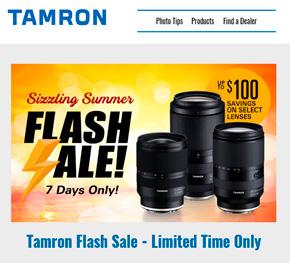
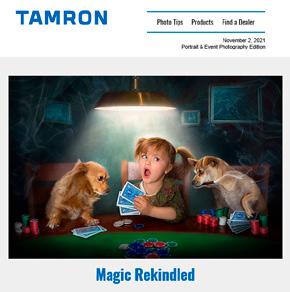

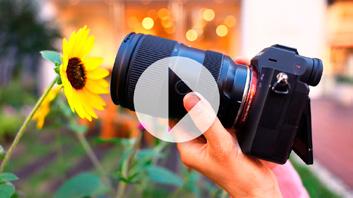

NEWS SUBSCRIBE TODAY AT www.youtube.com/TamronVids SUBSCRIBE TO ALL FOUR TODAY AT bit.ly/TamronNewsSignUp 4 Tamron Magazine 60-SECOND LESSONS NEW PRODUCT HIGHLIGHTS BEHIND THE SCENES VIDEOS Aspirational and how-to videos from the pros. Tips from the pros, new product info and specials delivered to your inbox. CHECK US OUT ON... SUBSCRIBE TO OUR... eNewsletter FOUR SUBSCRIPTIONS TO CHOOSE FROM! 3 Portrait and Events 3 Everything Nature and Travel 3 World of Close-up and Art 3 General news, events and promotions
JOSE MOSTAJO

Jose Mostajo is a Peruvian travel and adventure photogra pher based in the US. His 11-month backpacking trip across South America in 2018 ignited his passion for the outdoors and world travel. His work has led to partnerships with a variety of organizations such as the Australian Tourism Board and the Environmental Defense Fund, and commercial work with companies such as Enterprise, Columbia, and Hilton Hotels. With his photography, he hopes to inspire people to get outside and enjoy nature.
Instagram: @josemostajo

HIGHLIGHT
35-150mm (35mm), F/2.0, 1/800 sec., ISO 100
TOP FEATURES OF THE 70-300MM F/4.5-6.3 DI III RXD
NIKON Z-MOUNT
World’s smallest and lightest telephoto zoom for full-frame mirrorless cameras
The 70-300mm F4.5-6.3, now available for Nikon Z-Mount mirrorless cameras in addition to the previously released version for Sony E-Mount, was designed and created so photographers of all skill levels can enjoy high quality images comfortably and is the most compact and lightweight in its category.1 It’s a versatile lens for photographing landscapes, sports and other action, pets, wildlife and more. The lens also demonstrates its potential for portrait shooting, casual snapshots and scenarios that require you to be mobile and shoot handheld, like sporting events. And on APS-C cameras, the lens provides an 105-450mm full-frame equivalent focal range.
Compact telephoto zoom
Designed specifically for mirrorless cameras, and with an F6.3 aperture at the telephoto end, the 70-300mm F4.56.3 is the world’s smallest and lightest full-frame mirrorless telephoto zoom lens, coming in at a mere 5.9” long with a maximum diameter of 77mm and weighing just 20.5oz. Easier than ever before, photographers can now experience the compression effects and limited depth-of-field unique to a real telephoto lens. This lens is also ideal for users who want to reduce the weight of their camera bag or lighten their load on nature walks.
Superior optical performance and supreme lightweight portability
Based on thorough simulations utilizing the latest design technologies, the optical design of the 70-300mm F4.56.3 successfully balances its compact

Light & Compact 5.9” long & 20.5 oz.
RXD autofocus
FOR
Moisture-resistant lens construction Uniform Ø67mm filter BBAR Coating Tamron Lens Utility™ USB port MOD 31.5” (70mm)
(Rapid eXtrasilent Drive)
* Varies by
bodies TOP FEATURES
6 Tamron Magazine
camera
Circular aperture
HIGHLIGHTS IN FOCUS:
size and high image quality. The optical construction includes 15 elements in 10 groups, with an LD (Low Dispersion) lens element precisely arranged to suppress axial chromatic and other aberrations that are likely to occur with telephoto zoom lenses. At 300mm, a commonly used telephoto focal length, the design delivers excellent resolution from edge-to-edge. The new zoom creates extremely crisp and clear images throughout the entire zoom range due to Tamron’s BBAR Coating, which is worldrenowned for its anti-reflection performance.
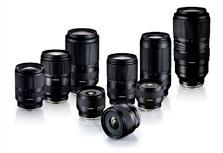
The RXD (Rapid eXtra-silent stepping Drive) stepping motor unit is exceptionally quiet
The AF drive incorporates a sensor that accurately detects the position of the lens while the RXD motor unit delivers optimized AF control. This achieves very fast and accurate autofocus operation and allows users to maintain tack-sharp focus on continuously moving subjects often shot with telephoto zoom lenses. Thanks to the exceedingly quiet AF, the lens can be used discreetly in concert halls and other situations that require low noise levels, as well as for video shooting.
Moisture-Resistant Construction for added protection
Seals are located at the lens mount area and other critical locations to deter infiltration of moisture and/or rain and afford MoistureResistant Construction. This feature provides an additional layer of protection when shooting outdoors under adverse weather conditions.
Dedicated TAMRON Lens Utility software


With this new “Nikon Z mount system” compatible version, users can employ the dedicated Tamron Lens Utility™ software that was developed in-house by Tamron. This feature enables users to easily update the lens to the latest firmware themselves, without going through the camera.2
67mm filter size
The shared 67mm filter size en ables efficiency in filter use; the same polarizer filter, or others, and lens caps can be shared be tween most models in Tamron’s mirrorless line-up.
Low Dispersion Element
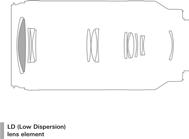
LD lens elements help reduce chromatic aberrations. Chro matic aberration reduces the sharpness of an image, but glass with an extremely low disper sion index has less of a tendency to separate (diffract) a ray of light into a rainbow of colors. This characteristic allows the lens designer to effectively compen sate for chromatic and lateral chromatic aberration which are a particular problem at wide-angle and telephoto focal lengths.
Superb image quality
With special emphasis on
TOP FEATURES
1 Among 300mm-capable telephoto zoom lenses for full-frame mirrorless cameras (As of August, 2022: TAMRON) 2 As the 70-300mm F4.5-6.3 is not equipped with a Focus Set Button, certain functions cannot be customized.
NEW 70-300mm F/4.5-6.3 Di III RXD Model A047 Focal Length 70-300 Max. Aperture F/4.5-6.3 Blades 7 (circular diaphragm) MOD 31.5 in (WIDE) 59.1 in (TELE) Length 5.9 in Weight 20.5 oz. Filter Size ø67mm Max. Diameter ø77mm Mount* Nikon Z-Mount *See website for Sony E-Mount specs
70mm, F/16, 0.6 sec, ISO 100 with NIKON Z © Yukie Hayashi
Di III RXD
70-300mm F/4.5-6.3
resolving power,
users can enjoy high-resolution images com bined with the stunning bokeh qualities that are achievable only with a telephoto lens.
Regular Optica Glass Image plane LD Glass Regular Optica Glass Image plane Image plane LD Glass Tamron Magazine 7 SEE THIS LENS IN ACTION @TAMRONVIDS
TOP FEATURES OF THE 150-500mm F/5-6.7 Di III VC VXD
The new 150-500mm F/5-6.7 Di III VC VXD for FUJIFILM X-Mount features a very compact design, high image quality. This amazing zoom lens achieves a 750mm full-frame equivalent focal length while retaining a compact size with a length of just 8.3” and a maximum diameter of 93mm. Equipped with VC (Vibration Compensation), the lens is easy to carry and comfortable to shoot handheld. The design places major emphasis on image quality with an optical construction that features 25 elements in 16 groups and utilizes special lens elements and hybrid aspherical lens elements to control chromatic aberrations. BBAR-G2 Coating is used to suppress ghosting and flare, which could otherwise occur under backlit conditions. The 150-500mm F5-6.7 is a highly versatile lens that lets you capture a wide array of subjects ranging from landscapes and birds to sports and wildlife.

High-speed, high-precision AF means you’ll never miss a photo opportunity
The 150-500mm F5-6.7 zoom’s AF drive system is equipped with the VXD linear motor focus mechanism. The VXD mechanism delivers extreme highspeed and high-precision movement and ensures exceptionally responsive performance when photographing subjects such as wild birds, sports, vehicles, and wildlife in general. The linear motor also suppresses drive noise and vibrations during focusing, making it ideal for shooting both still photos and video in environments that demand quietness.
Ø82 filter BBAR-G2
Arca-Swiss Compatible Tripod Mount with strap holes MOD 23.6"
70.9"
FLEX ZOOM LOCK mechanism New! MF Speed Switch
FOR FUJIFILM X-MOUNT MIRRORLESS Moisture resistant lens construction Camera-based lens unit firmware updates*
Coating Removable
(150mm)
(500mm)
VXD autofocus (Voice-Coil eXtremetorque Drive)
High-speed, high precision AF and Tamron’s VC make comfortable handheld photography with an ultra-tele zoom a reality
* Varies by camera bodies TOP FEATURES Limit AF Switch Fluorine Coating 8 Tamron Magazine
HIGHLIGHTS IN FOCUS:
150-500mm F/5-6.7 Di III VC VXD
VC delivers excellent image stabilization
The lens features three VC mode settings (Mode 1: Standard, Mode 2: Exclusively for Panning, and Mode 3: Framing Priority) so the ideal mode can be used to match shooting conditions.

VC image stabilization facilitates shooting handheld at the ultra-telephoto position
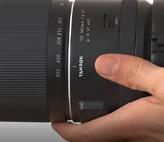
With special emphasis on resolving power, when shooting in the ultra-telephoto range, even the smallest vibrations can lead to loss of image clarity. The 150-500mm F5-6.7 is equipped with VC functionality to support sharp images despite unavoidable camera shake. VC delivers powerful support for handheld shooting of scenes with low light levels, such as at evening and indoor, without the use of a tripod. The lens also features a VC mode selection switch with three modes including a dedicated panning mode, and "Framing Priority" in which VC Stabilization is engaged from the time power is turned on.
Exciting telephoto macro focuses as close as 23.6”

The 150-500mm F5-6.7 offers excellent close-up shooting capabilities for an ultra-telephoto lens. The MOD is 23.6” at the 150mm end and 70.9” at the 500mm telephoto end. The maximum magnification ratio at 150mm is exceptionally high at 1:3.1 (full-frame equivalent of 1:2.1). Users can shoot powerful telephoto-macro images of subjects including flowers and insects while maintaining a reasonable shooting distance — closer than you can get with conventional ultra-telephoto zoom lenses.
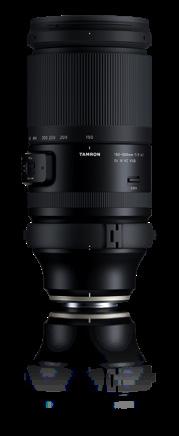
MF SPEED switch for greater Manual Focus control
The FUJIFILM X-mount version features an "MF SPEED switch.” The switch allows you to select between two focusing speeds during manual focus shooting. This switch is useful when you are using the camera's LCD monitor to magnify the image for precise focusing. It facilitates accurate shooting in the telephoto to ultra-telephoto range of 225-750mm (fullframe equivalent).
75° Zoom Ring Rotation Arc
The lens zooms from 150mm to 500mm by rotating the zoom ring through an arc of just 75° — less than one-quarter of a turn. This feature enables rapid adjustment to the desired angle of view with minimal movement, avoiding missed opportunities and facilitating intuitive composition.
FLEX ZOOM LOCK mechanism
Quickly lock or unlock the zoom at any position simply by sliding the zoom ring. Photog raphers can shoot at any angle without the lens extending unintentionally.
Lens hood designed with rubberized front
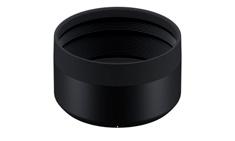
The end of the included lens hood is protected with flexible, shock-absorbing front rim to prevent cracks and damage.
Removable Arca-Swiss compatible tripod mount
Strap attachment holes are conveniently located in the ArcaSwiss compatible tripod mount, and the overall balance with the strap attached, with regard to center of gravity, is excellent.
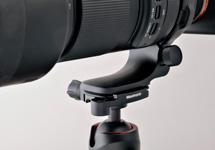
TOP FEATURES
NEW 150-500mm F/5-6.7 Di III VC VXD Model A057 Focal Length 150-500 Max. Aperture F/5-6.7 Blades 7 (circular diaphragm) MOD 23.6 in (WIDE) 70.9 in (TELE) Max. Mag. Ratio 1:3.1 (WIDE) 1:3.7 (TELE) Length 8.3 in Weight* 60.3 oz. Filter Size ø82mm Max. Diameter ø93mm Mount** FUJIFILM X-Mount *Without tripod mount (5.5 oz.) **See website for Sony E-Mount specs 299mm, F/6.3, 1/100th sec, ISO 1250 ©Ken Hubbard
SEE THIS LENS IN ACTION @TAMRONVIDS Tamron Magazine 9
TOP FEATURES OF THE 20-40MM F/2.8 DI III VXD
FOR SONY E-MOUNT
Category-disrupting ‘Standard Zoom’ for still photography and video covers 20-40mm and offers class-leading compact size and light weight
The 20-40mm F/2.8 Di III VXD (Model A062) is Tamron’s innovative, fast-aperture Sony E-mount zoom lens that will change your mind about standard zooms. The lens starts from 20mm at the ultra-wide-angle end and covers up to 40mm in the standard focal range. Even with the breadth of the zoom range, this lens is the smallest and most lightweight in its class.1 Useful in a wide variety of shooting situations, the new zoom is ideal for everything from casual snaps and family events to landscapes captured with natural compositions and perspective, and even indoor photography in tight quarters using the ultra-wide angle. In addition, the 20mm wide-angle field-of-view is also ideal for self-shooting during vlogs and other content.
An unprecedented compact and light weight design that shatters stereotypes of fast-aperture zoom lenses
The 20-40mm F/2.8 is a fast-aperture standard zoom lens but maintains its fast F/2.8 aperture across the entire zoom range while sporting a remarkably compact and lightweight design, just 3.4” long, with a maximum diameter of 74.4mm and weight of only 12.9 oz. With a size that is easy to carry and a light weight that’s well-suited for handheld shooting for extended periods, the 20-40mm F/2.8 will likely become your first choice for travel, street shooting, everyday carry, and spontaneous photo opportunities.
Control the composition as you shift seamlessly from the ultra-wide-angle to the standard focal length Compared to a conventional zoom lens that
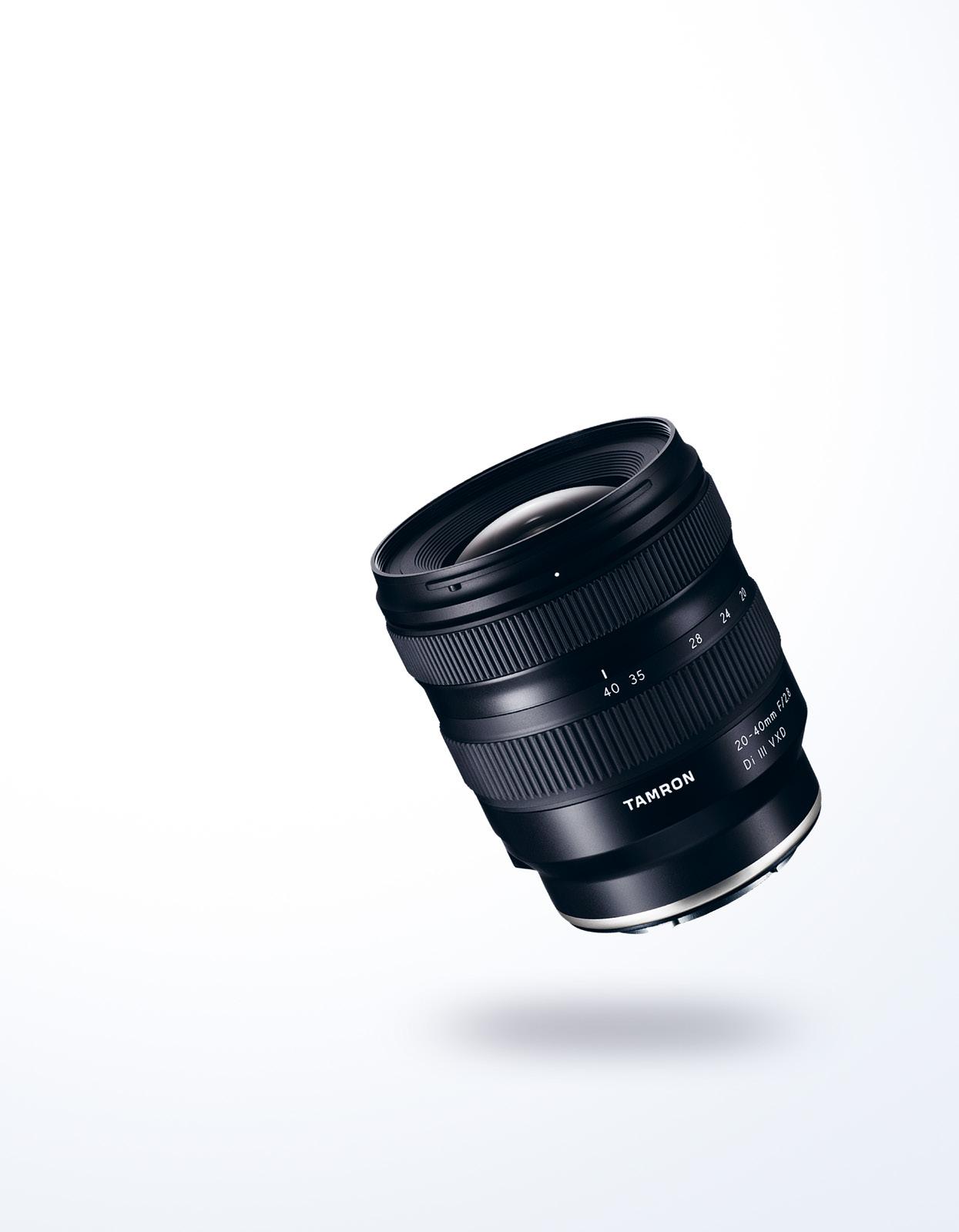
* Varies by camera bodies TOP FEATURES Circular aperture Light & Compact 3.4” long & 12.9 oz. Just 65° zoom ring rotation arc Uniform Ø67mm filter Fluorine Coating Moisture-resistant lens construction MOD 6.7” (20mm) VXD autofocus (Voice-coil eXtreme-torque Drive) Tamron
10 Tamron Magazine
Lens Utility™ USB port
HIGHLIGHTS IN FOCUS:
20-40mm F/2.8 Di III VXD
starts at 24mm, the difference is obvious the minute you bring the camera to your eye. When shooting landscapes, you can enjoy the wide-angle field-of-view and dynamic performance that only an ultra-wide-angle lens delivers. Moving in the other direction, the full zoom range covers up to 40mm, also offering popular 28mm and 35mm lengths. So, it’s ideal for snaps and casual portraits, too. When attached to an APS-C mirrorless camera it covers the full-frame equivalent focal length range of 30-60mm.
Awesome videos and selfies at 20mm with fast, high-precision AF
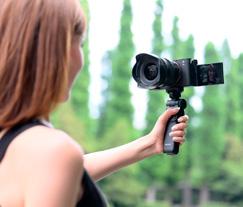
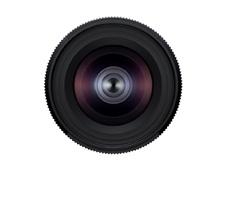
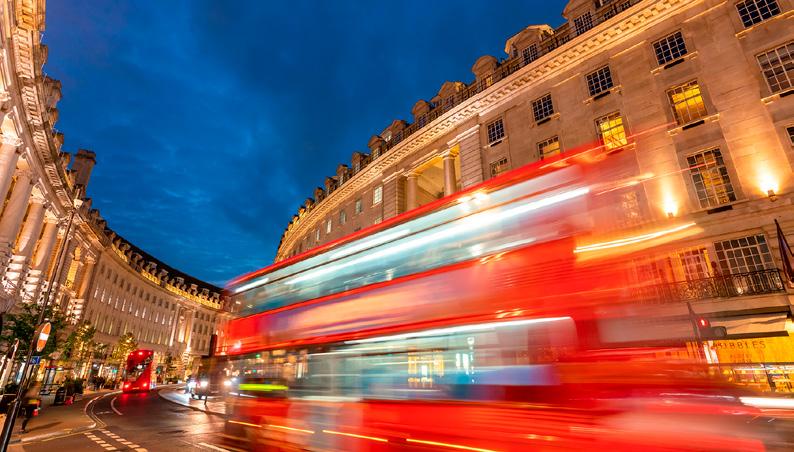
The excellent handling benefits inherent in the compact and lightweight design are especially useful when shooting video. The lens remains well-balanced when using a camera rig, cage, or gimbal stabilizer, so it’s an excellent choice for vlog shooting. One advantage of the 20mm ultra-wide focal length is that a broad expanse of the background can be incorporated. Excellent focus tracking performance allows you to track movement steadily when shooting video. In addition, noise from the AF motor is minimized, making it ideal for still and video when shooting in conditions where silence is required.
Compact body with high image quality
The 20-40mm F/2.8 is packed with unique Tamron innovations that enable it to have a compact body while ensuring high image

quality. One of the greatest appeals of this zoom is the creamy, beautiful bokeh that is distinctive to large aperture lenses. Additionally, the BBAR-G2 (Broad-Band AntiReflection Generation 2) Coating, Tamron’s next-generation technology, suppresses ghosting and flare to enable the crisp and clear rendering of images.
Close-focusing wide macro shooting with a 6.7” MOD at the 20mm end The excellent close-range shooting performance, which achieves an MOD of 6.7” at the 20mm wide end with a maximum magnification ratio of 1:3.8, produces rich and dynamic imagery that brings out the finest details of the subject and gives you another avenue of creativity.
67mm filter size
The shared 67mm filter size en ables efficiency in filter use; the same polarizer filter, or others, and lens caps can be shared be tween most models in Tamron’s mirrorless line-up.
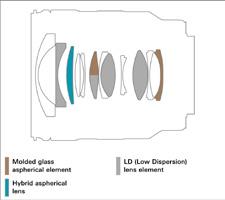
Compatible with Tamron Lens Utility™ software
Customize for excellent videog raphy use. Focus ring settings can be changed to suit shooting style and you can update to the latest firmware.
Moisture-resistant construction Seals at all critical points in the lens to provide extra protection when shooting in inclement weather.

Superb image quality
Excellent sharpness corner to corner throughout the zoom range.
TOP FEATURES
20mm, F/6.3, 1/5 sec, ISO 1000
© Itsuka Yakamo
1 Among fast-aperture zoom lenses for Sony E-mount fullframe mirrorless cameras (As of September, 2022: TAMRON)
NEW 20-40mm F/2.8 Di III VXD Model A062 Focal Length 20-40 Max. Aperture F/2.8 Blades 9 (circular diaphragm) MOD 6.7” (WIDE) 11.4” (TELE) Max. Mag. Ratio 1:3.8 (WIDE) 1:5.1 (TELE) Length 3.4” Weight 12.9 oz. Filter Size Ø67mm Max. Diameter Ø74.4mm Mount Sony E-Mount Tamron Magazine 11 SEE THIS LENS IN ACTION @TAMRONVIDS
ON THE ROAD IN THE CANADIAN ROCKIES
Ken Hubbard explores Jasper and Banff with the compact new Tamron 20-40mm F2.8 zoom.
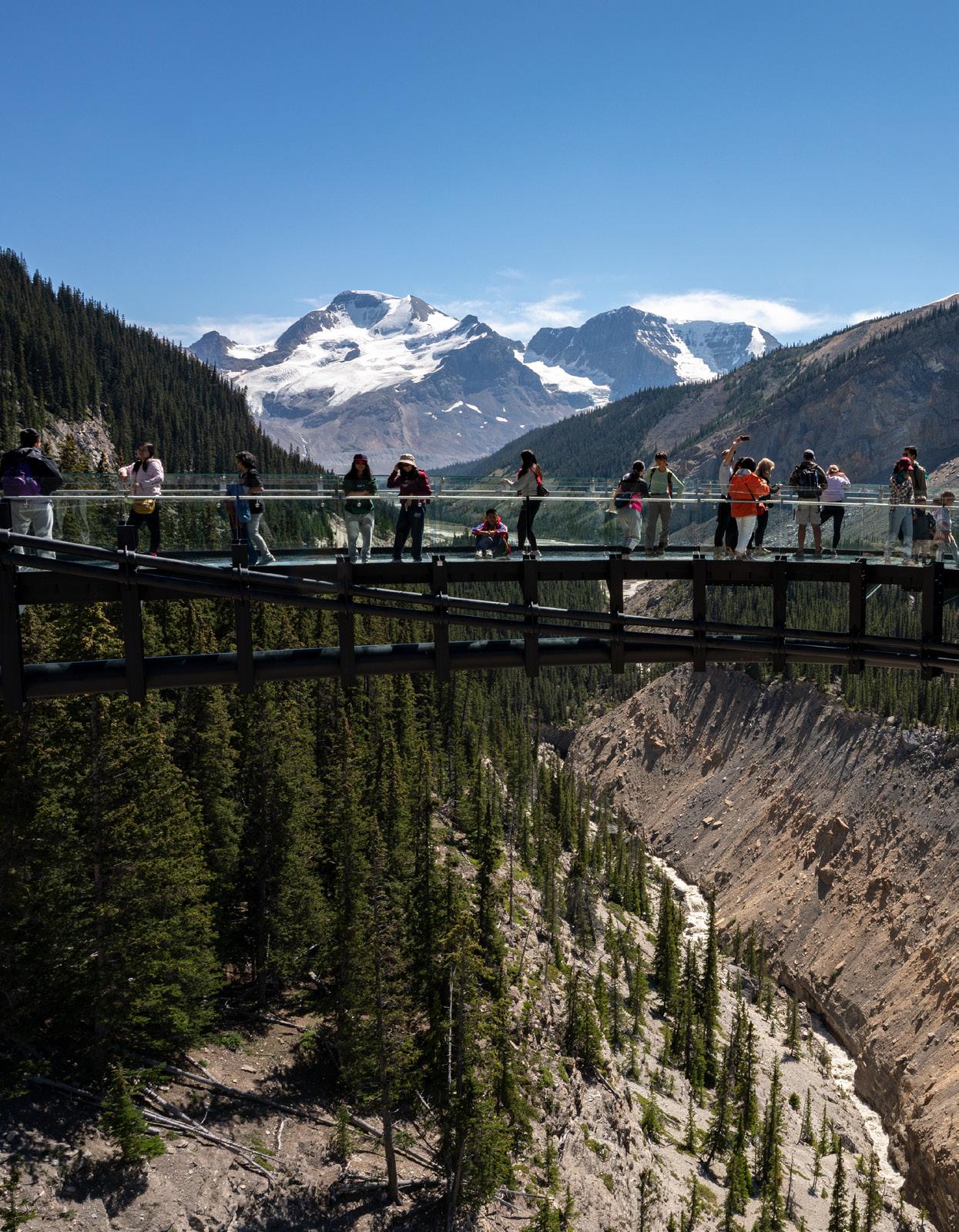
12 Tamron Magazine PRACTICE
PHOTOS: KEN HUBBARD
20mm, F/16, 1/50 sec., ISO 200
31mm, F/18, 1/500 sec., ISO 640
The approximately 100-mile trek between Banff National Park and Jasper National Park offers some of the most spectacular scenery in Canada’s Alberta province. That’s why when Ken Hubbard took a road trip through this area in the Canadian Rockies, he knew he was going to need a special lens to capture it. “André Costantini and I were up there to shoot a ‘first-look’ style video,” Ken says. “I’d just received the new Tamron 20-40mm F/2.8 Di III VXD standard zoom a couple of days earlier, and I was excited to put it to the test on this trip.”
It was a journey rife with magnificent backdrops. “When you’re in the US Rockies, you feel encompassed by them,” Ken says. “It’s sometimes hard to get a true sense of just how big they really are. In the Canadian Rockies, however, it’s more like you’re in a never-ending valley, where you can really take all of the mountains in. They seem so much more grand, and if you drive more than a minute without seeing a glacier, that’s a long time. It’s just one after the other, which is great for photo opps.”
With focal lengths that start at the ultrawide 20mm and cover up to 40mm, the new 20-40mm proved a perfect landscape lens for Ken’s Canadian adventure. “The key to the 20-40mm lens is the versatility offered by its focal-length range,” he says. “I shoot a ton within in that range, so it felt very comfortable to me. Plus, my images always come out tack-sharp corner to corner with this lens, which is important when you’re trying to capture all of the details in the rocky landscapes.”
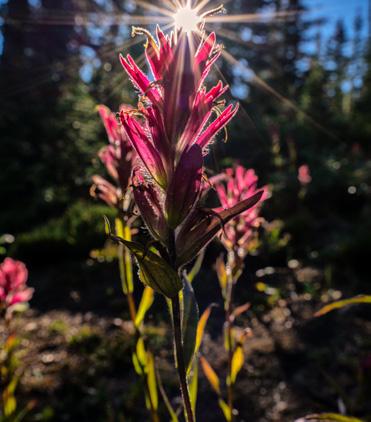
In addition to the 20-40mm’s ability to take in the vast Alberta landscapes, it also
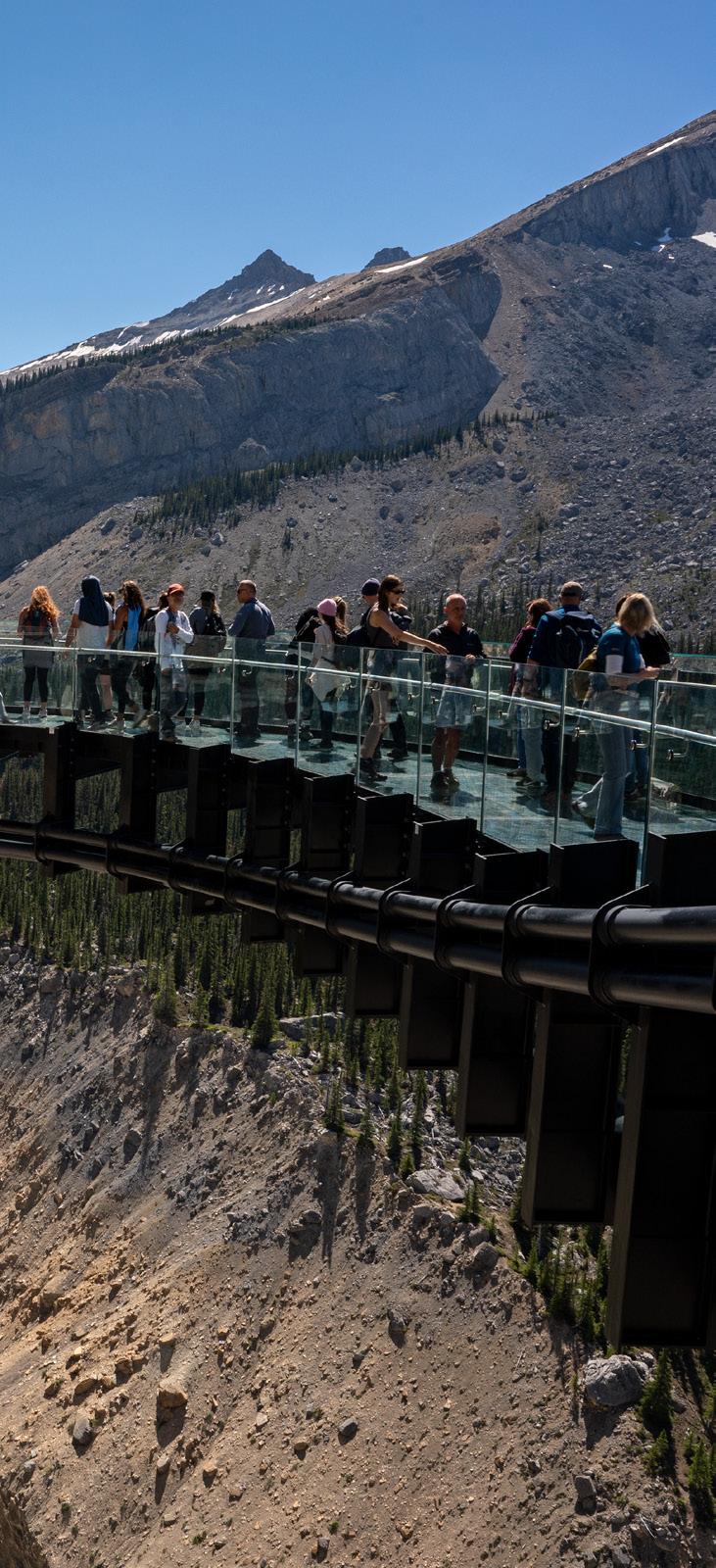
Tamron Magazine 13 PRACTICE
offered macro-style close-shooting opportunities thanks to its Minimum Object Distance of 6.7 inches and maximum magnification ratio of 1:3.8 at the 20mm end (11.4 inches on the tele end). “Close focusing at such a wide angle gives you a completely different perspective when you’re photographing flowers and other native plants,” Ken says. “When you’re shooting macro at, say, 90mm, you’ve got a tighter field of view. With this lens, I was able to create some beautiful super-close-up work, but still include some of the background, like in the flower photo here. You’ve got the flower in the photo, but also the sunburst and the trees.”
At just 3.4 inches long and weighing only 12.9 ounces, the 20-40mm lens boasts a remarkably compact and lightweight design ideal for travel and landscape photography. “We spent a good amount of time exploring Parker Ridge, a mountain ridge in Banff,” Ken says. “You go from 6,000 feet to nearly 7,400 feet in just a mile and a quarter— that’s almost a 1,500-foot elevation rise in a relatively short distance. I didn’t want to have heavy gear weighing me down, and this lens served that purpose well. I didn’t even have a camera bag: I brought a backpack with my camera body, the 20-40mm, and a few accessories.”
Having an F/2.8 maximum aperture in such a compact lens also proved beneficial. “Often when the light gets dim, you have to whip out massive, bulkier lenses to achieve that F/2.8 aperture while handholding,” Ken says. “This area of the Canadian Rockies is a wonderful place to do a lot of night shooting, and that’s where the F/2.8 can come in particularly handy, because you need the widest aperture possible for that.” The 20-40mm’s AF drive employs the high-precision VXD (Voice-coil



PRACTICE
20mm, F/11, 1/50 sec., ISO 200 21mm, F/16, 1/640 sec., ISO 640 38mm, F/14, 1/50 sec., ISO 200
20-40MM
"THE KEY TO THE
LENS IS THE VERSATILITY
OFFERED
BY ITS FOCAL-LENGTH RANGE.”
eXtreme-torque Drive) linear motor focus mechanism, which ensures fast, accurate focusing. “We took a helicopter ride, and that chopper was constantly changing positions and perspectives, at the will of the pilot,” Ken says. “Having that super-fast autofocus that could lock on to whatever I was shooting before he veered off in another direction was a great help.”
Shooting video with the 20-40mm is also made simple, thanks to its light weight and compact size. “It’s easy if you’re a videographer to put this lens on a camera rig or gimbal stabilizer,” Ken says. “Plus, the 20mm to 24mm is a popular focal length for shooting video, the F/2.8 aperture is ideal in lowlight situations, and it allows for steady focus tracking when you’re following movement. The autofocus is also exceptionally quiet thanks to that VXD mechanism, which is important when you need silence in your video.”
Even the 20-40mm’s look and feel is appealing. “I know that might sound funny to some people, but for
photographers, if you don’t like the feel of something you’re going to be holding in your hand the whole day, you’re not going to want to use it as much,” Ken says. “The coating used on the exterior of the 20-40mm offers it a high-quality look and feel. I actually thought it felt like metal when I first got it in my hands. This is an amazing lens all around, especially for its price point.”
NEW
20-40mm
ABOUT: KEN HUBBARD
Ken Hubbard is the Field Services Manager for Tamron.

He is responsible for the company’s events, including Tamron’s popular consumer workshop series. Ken has had nationwide gallery showings of his portrait and landscape photography and teaches enthusiasts how to take better photos at numerous events.

Focal Length 20-40 Max. Aperture F/2.8 Blades 9 (circular diaphragm) MOD 6.7” (WIDE) 11.4” (TELE)
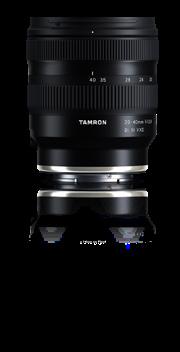
Max. Mag. Ratio 1:3.8 (WIDE) 1:5.1 (TELE) Length 3.4”
Weight 12.9 oz.
Filter Size Ø67mm
Max. Diameter Ø74.4mm
Mount Sony E-Mount
Ken’s extensive background in the field of photography is unique and diverse. He has traveled extensively throughout the US and the result is a consistent output of breathtaking photographs that continually challenge the boundaries of the genre.
Tamron Magazine 15 PRACTICE
PHOTOS: KEN HUBBARD
20mm, F/22, 1.0 sec., ISO 50
“WITH THIS LENS, I WAS ABLE TO CREATE SOME BEAUTIFUL SUPERCLOSE-UP WORK, BUT STILL INCLUDE SOME OF THE BACKGROUND.”
Instagram: @kenhubbardphotography F/2.8 Di III VXD
Model A062
PRO TIPS FOR WILDLIFE PHOTOS
Forge a bond between viewer and subject with Tamron’s suite of wildlife-friendly lenses.
 ©
Alyce Bender
©
Alyce Bender
SPECIAL
Wildlife photography isn’t for the faint of heart. It takes perseverance, flexibility, and, in some cases, a bit of daring—if you’ve ever come relatively close to a big cat or brown bear, or stared down a bald eagle, you know that adrenaline jolt we’re talking about. No matter what the situation, Tamron has a suite of lenses ready to capture photos of creatures great and small, including wide-angle lenses like the 11-20mm F/2.8 and 17-28mm F/2.8 to incorporate more of your subjects’ habitat, to all-in-one telephoto lenses like the 18-400mm VC, to ultra-telephoto zooms like the 150-500mm VC and 150-600mm VC G2 for the longest reach with the least intrusiveness. Read on for guidance from Tamron’s photographic experts on how to craft stunning images, whether your subjects are roaming the savannas of Africa, trekking over the Arctic tundra, or bursting out of Monterey Bay in a splash-filled breach.
1 - KNOW YOUR LOCATION.
Research the rules for wildlife viewing in the destinations you’re visiting. Understanding potential subject behavior so you’ll know if an animal is stressed or uncomfortable with your proximity is an important step in the plan ning process. A rule of thumb: If the animal changes its behavior (e.g., stops eating, moves away, freezes while staring at you), you’re too close. If you’re working with animals that are habituated to people, and the rules allow for an ethical close approach, consider utilizing an ultra-wide lens to give the viewer a sense of being right there next to the animal with you.


Tamron Magazine 17
10-24mm (13mm), F/7.1, 1/200th sec., ISO 800 SPECIAL © Alyce 150-600mmBender(550mm), F/7.1, 1/800th sec., ISO 3200
2 - LOOK FOR UNIQUE WAYS TO PHOTOGRAPH YOUR SUBJECT.
This can help diversify your wildlife portfolio. You can do this by isolating just a portion of your subject’s body or face to convey a more intimate moment, rather than taking a traditional portrait. In the case of the sea lion shown here, the photographer was within close range, with a retaining wall between themselves and the animal. The photographer waited until the sea lion happened to look their way before capturing this image with their Tamron 150-600mm G2 and a shallow depth-of-field.
3 - KEEP A LOW PROFILE.
Disturbing the animal as little as possible is best practices when it comes to wildlife ethics. Position yourself in a spot so you can ensure an optimal composition, instead of having to chase or track your subject down. You’ll achieve photographs with more authentic animal behavior that way, as they (hopefully) won’t be affected by your presence. Set up in a sheltered, wooded area behind trees or in concealing grass to keep yourself out of sight. You might want to consider wearing camouflage and purchasing camouflage camera body and lens cover kits. This will help break your shape up, allowing you to blend more naturally into your subject’s environment.
4 - USE AUTO ISO.
By doing so in manual mode, this allows the photographer to set their shutter speed and aperture while the camera adjusts the ISO based on its meter reading. The reason this is so helpful is that many times your subject can move from one lighting extreme to another, causing variances in proper exposure. Using Auto ISO, the camera will adjust for those variances, giving the photographer one less thing to think about. It ensures the shutter speed is kept high enough so that you don’t get motion blur.
5 - SEEK OUT COLOR.
That might mean incorporating spring flowers in the foreground or vibrant fall colors in the background. Adding that bit of color can add extra pop to your wildlife images. Also, not every wildlife photo has to be shot at 600mm—zoom out and include some of your subject’s background to show that color, and more of the environment.

6 - CAPTURE AN ANIMAL’S STARE.
We have a natural inclination to make eye contact. When you zoom in on an animal’s eyes, especially a larger animal that we don’t typically get to see up close, it forges an immediate intimacy and connection between the animal and the viewer.

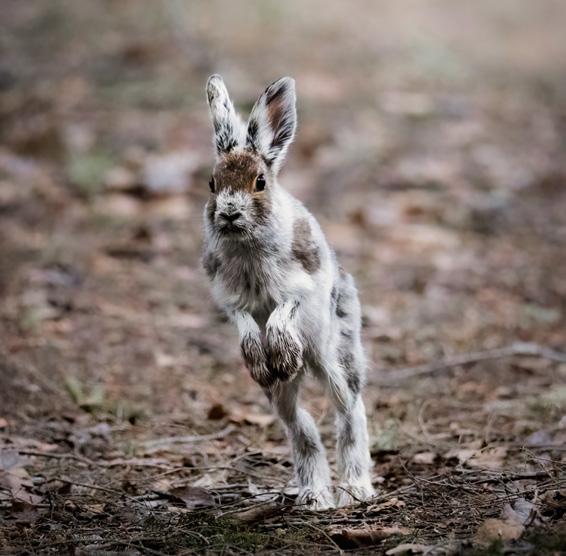
18 Tamron Magazine SPECIAL
“POSITION YOURSELF WHERE YOU CAN STUDY THE ANIMALS TO SEE HOW THEY ENGAGE WITH THEIR ENVIRONMENT AND EACH OTHER.”
— DAVID AKOUBIAN
© Seth Macey
© Cecil Holmes
© Cecil Holmes
7 - EXPERIMENT WITH DIFFERENT LIGHTING ANGLES.
Although it’s conventional wisdom to have the sun behind you when taking wildlife photos, capturing an image where your subject is sidelit or backlit can also offer dramatic images.

8 - POSITION YOURSELF AT EYE LEVEL WITH YOUR SUBJECT AS IT’S ON THE MOVE.
Especially with larger animals, like the ones you might en counter on an African safari, this offers the viewer the feeling that they’re right there with you as an animal makes its ap proach. Just be sure to use an ultra-telephoto lens with plenty of reach so you’re able to keep a safe distance.


9 - BE PREPARED FOR FASTER-MOVING BIRDS.
This is especially true for birds in flight. In such cases, a shut ter speed of at least 1/1000th of a second is crucial to freeze their movements and capture details. You’ll also want to pin point the places where birds frequent. For instance, if eagles are flying down to a beach to scoop up fish that’s washed up on the shore, you can position yourself upwind so the eagles will be facing you as they land. Simply set your focus system to continuous tracking and get ready for some great pictures.

10 - OBSERVE HOW THE ANIMALS MOVE AND INTERACT.
Position yourself where you can study the animals to see how they engage with their environment and each other. For instance, if you see a mother bear with cubs who keeps rising up out of the grass every time another bear approaches, you’ll know to look for that indicator of another bear nearing so you can ready yourself for a photo.

Counter Clockwise from top left
150-600mm (483mm), F6.3, 1/1250 sec., ISO 12,800
150-500mm (470mm), F/6.3, 1/100 sec., ISO 4000
150-500mm (200mm), F/6.3, 1/800 sec., ISO 160
150-500mm (500mm), F/7.1, 1/640 sec., ISO 640
150-500mm (444mm), F/8.0, 1/4000 sec., ISO 1250
150-500mm (500mm), F/8.0, 1/250 sec., ISO 250
150-600mm (320mm), F/6.1, 1/250 sec., ISO 1000
150-600mm (600mm), F/8.0, 1/100 sec., ISO 1250
Tamron Magazine 19 SPECIAL
© David Akoubian
© Luke Stackpoole
© Luke Stackpoole
© Luke Stackpoole
© David Akoubian
11 - LOOK FOR ENVIRONMENTAL HINTS ON HOW YOUR SUBJECT WILL REACT.
If you’re on a boat photographing a bear hunting for its dinner, for example, observe the bear for a while to give yourself a sense of what prompts its dives. Because salmon are bright ly colored, if you see the fish swim in front of a bear, you can be sure the bear will soon be making that dive.

Whale-watching is another instance when other animals can offer a hint on what your subject might do next. A fun activity to photograph with these marine creatures is surface lunge-feed ing, when humpbacks trap schools of fish at the surface and surge through them with their mouths agape, catching as many as they can. A feeding frenzy can sometimes last for hours. Even though you may not know where this type of event will take place, if you see a lot of birds gathering in one spot, that’s a sign that that’s where the fish are—meaning the whales won’t be far behind.
12 - REMEMBER THE TWO “P’S”: PERSISTENCE AND PATIENCE.
These points will keep you alert for photo opps, whether you’re wandering the landscape or waiting things out at an observation point. Set your exposure and keep your camera in “sleep” mode to save battery power. Once the wildlife appears, you can quickly tap your camera on and start firing off frames.

13 - CONCENTRATE ON THE FUNDAMENTALS.
Typically that means exposure, focus, and fram ing. Wildlife won’t “do that just one more time,” and animals often won’t appear in the exact place you were hoping for. That’s why you might want to set your camera up for slight overexpo sure (in case the animal appears in the shade), nail how to quickly focus (one suggestion is to use back-button focus), and preframe your shots by predicting all the potential areas where the wildlife might enter the frame.
14 - LOOK FOR PATTERNS.
Large groups of wildlife offer you opportunities to get creative with pattern compositions. For a photo of a massive herd of wildebeest crossing a river, for example, you can use an ultra-tele photo lens like the Tamron 150-600mm, zooming in and out until you find the perfect focal length to capture the radiating pattern they create while climbing one of the riverbanks.

20 Tamron Magazine SPECIAL
© David Akoubian
© Dalton Johnson
© Ian Plant
— CECIL HOLMES
15 - WAIT FOR THE PERFECT POSE.
Make sure your subject strikes a dynamic and flattering pose. You typically want to ensure that your subject’s face is in favorable light, and that you’re seeing an attractive profile or portrait of the animal. To be more blunt: You want to avoid photographing the butt end of your subject. For this photo of a polar bear in the Canadian Arctic, waiting until it was staring at the camera and putting its best foot forward made the shot.

16 - USE A VERSATILE LENS THAT’S READY FOR THE UNEXPECTED.
Whale watching can be incredibly exciting. Photo graphing marine mammals is different than other wildlife photography, as everything is moving (including you in the boat), and you don’t know quite where or when the action, like a breach, will happen. A lens like the Tamron 18-400 is perfect for this type of situation—no matter where the action happens, you’re covered.

17 - MAKE YOURSELF AS NONINTIMIDATING AS POSSIBLE.
Smaller animals especially can get spooked and run to hide behind bushes or trees. As they try to assess how much of a threat you are, squat down to make yourself smaller. It also helps if you have your ISO, shutter speed, and aperture already set, so when the animal does finally poke its head out, you’ll be ready.

Counter Clockwise from top left
150-500mm (301mm), F/8.0, 1/2500 sec., ISO 1000 150-600mm (600mm), F/7.1, 1/800 sec., ISO 400 18-400mm (300mm), F/11.0, 1/1000 sec., ISO 400 150-500mm (500mm), F/7.1, 1/1600 sec., ISO 3200 150-600mm (600mm), F/6.3, 1/400 sec., ISO 1000 150-500mm (500mm), F/6.7, 1/500 sec., ISO 1250
SPECIAL
“NOT EVERY WILDLIFE IMAGE HAS TO BE SHOT AT 600MM— ZOOM OUT AND INCLUDE SOME OF YOUR SUBJECT’S BACKGROUND TO SHOW MORE COLOR, AND MORE OF THE ENVIRONMENT.”
© Tiffany Tang
© Ian Plant
© Douglas Croft
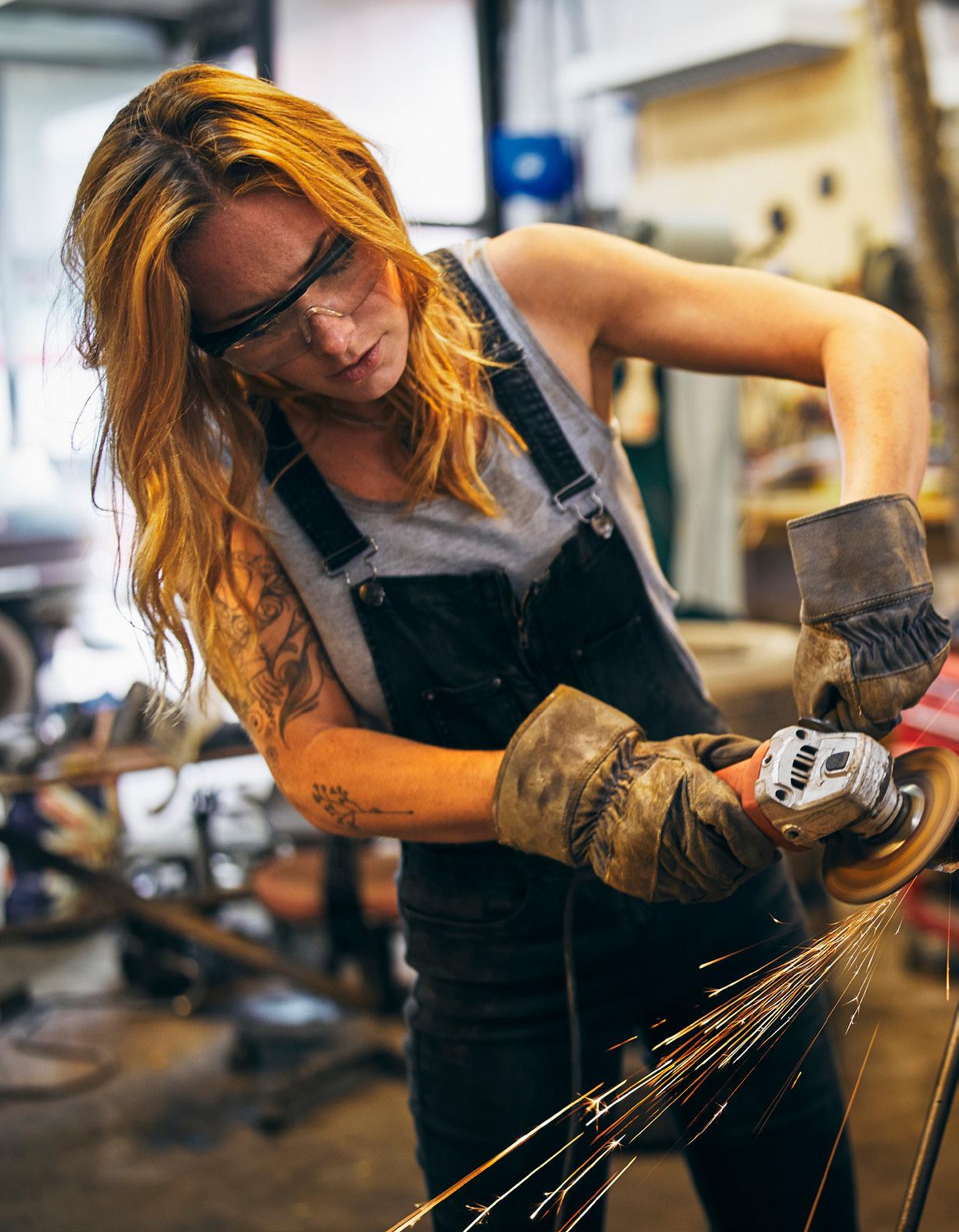
HIGHLIGHT
22 Tamron Magazine
©Thomas Kettner SP 35mm (35mm), F/1.4, 1/30 sec., ISO 200
THOMAS KETTNER

Thomas Kettner, renowned Photogra pher, Creative Director, Film Director and Publisher, was born in 1960 in Stuttgart, Germany and grew up in Johannesburg- South Africa and has worked for fashion and advertising clients like Boss, Baldessarini, Pierre Cardin, Givenchy, Cerruti, Davidoff, Lufthansa and Mercedes-Benz. Early in his career, he gained international recognition for his handling of shadow and light and his multifaceted portrayal of the female personality while underlining the individuality and inner world of women.
Instagram: @thomaskettner_official

HIGHLIGHT
TAMRON GOES TINSELTOWN

BRADLEY
PRACTICE
PHOTOS:
EVERETT YOUNG
Bradley Everett Young taps into Tamron’s 17-28mm and 28-75mm lenses to create cinematic portraits on the Hollywood scene.
28-75mm (28mm), F/11, 1/80 sec., ISO 400
Ask Bradley Everett Young to talk about the portraits he creates for actors in LA, and he doesn’t shy away from admitting that his black-andwhite photos are among his favorites. “I love the movies,” he says. “I’m drawn to photography from the ‘80s, as well as the ‘90s high-fashion style, so I always describe myself as an amalgam of Alfred Hitchcock meets Andy Warhol meets photographer Steven Klein.”

In addition to the classic cinematic appeal of black and white, that style of portrait also holds a sentimental one for Bradley. “My mom loved the movies and Hitchcock, too,” he says. “When she passed away in 2017, I didn’t shoot for a while, and when I came back to it, I went through a black-andwhite phase. It just kind of stuck.”
There’s another reason Brad is so taken with the allure of Hollywood: The Virginia native is an actor himself. “I moved to Los Angeles in 1999 when I was accepted to UCLA Medical School, and I had some acting connections through my sister, so I figured I’d dabble,” he says. “I ended up getting a gig and joining SAG after my very first audition, which is pretty rare out here.” In addition to parts in various commercials, TV series (Boy Meets World, Charmed, Grey’s Anatomy), and movies (Charlie’s Angels, Rumor Has It, Jurassic Park III), Brad has even done stints as a stuntman and served as a body double for actor Jeremy Piven and comedian Bill Maher.

Tamron Magazine 25 PRACTICE
17-28mm (27mm), F/9, 1/80 sec., ISO 250
To achieve his trademark portrait look, Brad uses the Tamron 17-28mm F/2.8 Di III RXD and 28-75mm F/2.8 Di III VXD G2 lenses on his Sony mirrorless camera system.
“I use bold lighting for my portraits, and I’m elated on how these two lenses are able to capture every intricate detail, whether I’m doing my classic black-andwhite series or shooting in vibrant color,” he says. “Plus, as much as I like to get in close and focus on a person’s eyes, I sometimes like to incorporate a



little more of the scene into the photo, depending on the type of session I’m doing. Maybe I’ll want to show a prop on the floor or an outstretched hand holding something. The wider angles afforded by these lenses let me do that.”
Many of the photos in Bradley’s black-and-white portrait portfolio bear a similar feel, with a simple white background and dramatic lighting. “I wanted all of my pictures in this vein to be unified from the beginning, so they can remain connected from the day I started until now,” he says. “That clean background allows me to focus on the actors’ facial expressions and whatever’s going on emotionally.”

As for lighting, every one of Bradley’s subjects gets a slightly different treatment. “Every skin tone is different,” he says. “There was a period when I was trying to use the same settings for everyone, and it wasn’t working with such extreme illumination. Now, as I’m talking to the actors, I’ll fiddle around with my f-stops and ISOs until I find what I think is best for each person. Because my lighting is always changing, I appreciate these Tamron lenses so much. I primarily shoot in manual, and they have the speed to adjust on the fly and keep up with me so I never miss a shot.”
Despite the fact that actors work in front of cameras all day long, they don’t always feel comfortable having their photos taken. “Casting managers are always asking me how I get my subjects to do the things they do in front of my camera,” Brad says. “Frankly, I don’t let them think too hard about what they’re
PRACTICE
17-28mm (27mm), F/9, 1/80 sec., ISO 250 17-28mm (28mm), F/11, 1/80 sec., ISO 125 17-28mm (23mm), F/10, 1/100 sec., ISO 250 28-75mm (38mm), F/10, 1/80 sec., ISO 250
doing. They’ll come in and we’ll chat for 10 or 15 minutes first, and then I’ll show them my selection of props.”
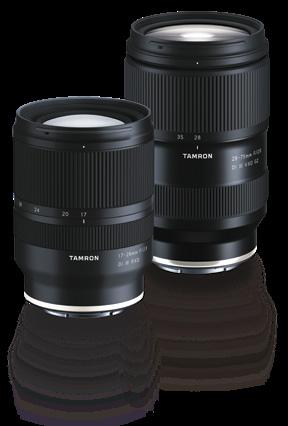
It’s those props that often help bring Brad’s portrait subjects out of their shells. “I’ll ask them if they want to pick up that fake knife or gun, or even a straitjacket I’d bought from a Halloween store,” he says. “They instantly gravitate toward those props, especially if they’ve always played a goody twoshoes or hero on a soap opera. Suddenly they’re acting—they’re crying, they’re screaming, they’re playing a part they’ve always secretly wanted to play. And that’s where some of my best photos emerge.”
When Brad takes photos of his subjects, he wants viewers to feel like they’re in the shot with them. “That’s why I usually shoot straight on, pointing my camera directly at my subject,” he says. “I’ll say, ‘Put your butt up against the wall and lean in toward me. Your head needs to be bigger in the photo.’ I want my pictures to have a very intimate, one-on-one vibe, so that the viewer feels like they’re having coffee with someone sitting
across the table, and that they could almost reach out and touch their face.”
It’s an intimacy that Brad hopes evokes a feeling of escapism. “It goes back to the whole cinematic theme and watching movies to escape,” he says. “I want you to look at one of my portraits and escape for a few seconds—forget about the kids, the bills, your job. Just sit with that photo and take it in. The world will still be there when you get back.”
ABOUT:
BRADLEY EVERETT YOUNG
An American (actor / photogra pher) based in Los Angeles. Brad is the founder of the Dream Loud Official visual campaign helping retain and restore the art and music programs in schools.


Brad is the lead photogra pher / producer / director for the campaign as well. Brad has photographed some of today’s biggest celebrities and worked with top brands around the world.
Instagram: @bradley206 TikTok: @BradEverettYoung
Tamron Magazine 27
PHOTOS: BRADLEY EVERETT YOUNG PRACTICE
"I’M ELATED ON HOW THE
17-28MM
AND
28-75MM
ARE ABLE TO CAPTURE EVERY INTRICATE DETAIL.”
28-75mm (29mm), F/10, 1/80 sec., ISO 400 28-75mm F/2.8 Di III VXD G2 [model A063] 17-28mm F/2.8 Di III RXD [model A046]
WIDENING HORIZONS
Lisa Langell sees new creative options for her wildlife and nature photography with the Tamron 50-400mm VC VXD ultra-telephoto lens.
 PHOTOS: LISA LANGELL
PHOTOS: LISA LANGELL
FIELD REPORT 28 Tamron Magazine
Each year, Lisa Langell heads north from Scottsdale, Arizona, to conduct her “Magic of Alaska” photo workshops. During her most recent journey to the Last Frontier, the nature and wildlife photographer brought along a new companion for her Sony mirrorless camera system: the Tamron 50-400mm Di III VC VXD ultra-telephoto zoom lens.
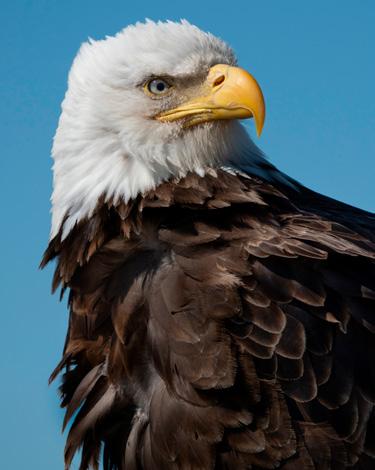
“I was somewhat of a skeptic at first, as I wasn’t sure if the 50mm end of the lens would prove useful for me as a wildlife photographer,” Lisa says. “But when I was standing on the beach and photographing birds, everything started to open up for me photographically. I realized I’d unknowingly opted out of so many moments in the past when it comes to taking photos at the wider end. It’s like thinking your whole life that you didn’t want to try Brussels sprouts, and then one day someone puts a dish of Brussels sprouts in front of you, roasted and sprinkled with bacon bits, and you realize: This is amazing!”
Whether she was experimenting with landscape images at 50mm, shooting video, or taking her signature photos of wildlife— everything from eagles and black-legged kittiwakes, to sea stars using the 50-400’s macro-style capabilities—Lisa was impressed with how her creativity level surged and her portfolio became ever more diverse.
“I could zoom in for the wildlife shots, but then go really wide to incorporate the wildlife into a landscape scene,” she says. “I learned that not every photo I take has to be an

FIELD REPORT
Tamron Magazine 29
50mm, F/9, 1/2000 sec., ISO 400 400mm, F/9, 1/2000 sec., ISO 500
up-close one. When I was on the beach photographing this eagle, I was about 10 to 12 feet away. At the 50mm end, I loved having the ability to show the sea and the mountains in the background for some more context on where I was. It’s an environmental image that tells even more of a story.”
When the bird turned its head to look at Lisa, she was able to zoom in for a closeup without missing a beat, or seeing any change in sharpness. “I was gifted
with two photo opportunities, which, if I’d had to go back to my car to grab another lens, might have disappeared,” she says. “That’s especially important when photographing wildlife, birds in particular, as they tend not to stay in one place for very long.”
Thanks to the 50-400mm’s VXD (Voicecoil eXtreme-torque Drive) linear motor focus mechanism and Tamron’s proprietary Vibration Compensation (VC) image stabilization mechanism, Lisa was
able to achieve super-sharp images no matter what focal length she was using. “It’s stunning how sharp this lens is,” she says. “Zoom lenses in general, and telephotos in particular, typically have a sweet spot in terms of sharpness, and once you wander out of that sweet spot, the sharpness starts to fall off. That wasn’t the case with this lens. It was flawless throughout the entire focallength range.”

Having the 50-400mm lens on her camera also prompted Lisa to supplement her wildlife photos with more landscape images than she usually takes. “One of the prettiest areas in Alaska is Skilak



195mm, F/6.3, 1/1250 sec., ISO 1250 50mm, F/8, 1/3200 sec., ISO 800 FIELD REPORT 50mm, F/6.3, 1/640th sec., ISO 4000 400mm, F/8, 1/1600 sec., ISO 1000 30 Tamron Magazine
"IN TERMS OF SHARPNESS, THIS LENS WAS FLAWLESS THROUGHOUT THE ENTIRE FOCAL-LENGTH RANGE.”
Lake, located on the Kenai Peninsula,” she says. “One of my favorite perspectives there is of this one tree sticking out of the top of that rock. I shot this photo here at 50mm, because I wanted to capture not only the tree, but the snow-covered mountains in the background, the blue sky with those pretty clouds, and the colorful reflections in the water. If I didn’t have a versatile lens like the 50-400 on my camera, I wouldn’t have been able to quickly zoom out to capture the entire scene.”
Conversely, Lisa used the 400mm end of the lens for landscape photos where she wanted to focus on certain elements. “Take that photo of the pine trees emerging out of the rocks, with the snowy mountains in the background,” she says. “I do have widerangle shots of that scene, but this lens allows me to find different moments with more depth and dimension. Here, I’m able to show those mountain birds perched on one of the rocks between the trees, as well as the color of the lichen on the rocks and how it reflects in the water. Being able to create these compression-style landscapes, where all of the elements are nicely layered, is a flexibility I enjoy having.”
Tapping into the versatility of the 50-400 to incorporate more landscapes into the mix could also prove lucrative. “I’m a wildlife photographer, and so I love taking closeup portraits at 400mm of animals and birds, like the one of the eagle you see here,” Lisa says. “But in terms of coming up with images that people might want
to hang on the walls of their homes, they might not be so keen on a 40-by-60 eagle head for their living room. But they may be interested in, say, the photo of the eagle sitting on that stump along the shoreline, because it shows more of the landscape.”

Lisa is heading next to Ecuador to photograph hummingbirds, and then to the Galapagos Islands, and the Tamron 50-400mm will be accompanying her on her journey. “It’s now my lens of choice for this kind of trip,” she says. “I want to pack light, and having an ultra-telephoto that’s so versatile that I don’t have to keep changing lenses in different environments, where there might be dust or sea spray, is invaluable. I’m a big champion now of the 50-400. Using it has been a fun, eyeopening exercise.”
ABOUT: LISA LANGELL

Lisa Langell is a full-time, awardwinning professional photographer from Scottsdale, Arizona—but is originally from Marine City, Michigan. She leads tours and workshops internationally and is genuinely passionate about three things: Creating emotionally evocative images of nature; providing exciting, fun and high quality learning experiences for her workshop participants; and being a good steward of our natural resources.
Instagram: @langellphoto
50-400mm F/4.5-6.3 Di III VC VXD

Model A067
Focal Length 50-400
Max. Aperture F/4.5-6.3
Blades 9 (circular diaphragm)
MOD 9.8 in (WIDE) 59.1 in (TELE)
Length 7.2 in
Weight 40.7 oz.
Filter Size ø67mm
Max. Diameter ø88.5mm
Mount Sony E-mount
PHOTOS: LISA LANGELL
FIELD REPORT
50mm, F/4.5, 1/2000 sec., ISO 125 Tamron Magazine 31
RETREAT TO THE BAYOU
Ian Plant’s Tamron lenses capture the primordial feel of the Southern cypress wetlands.
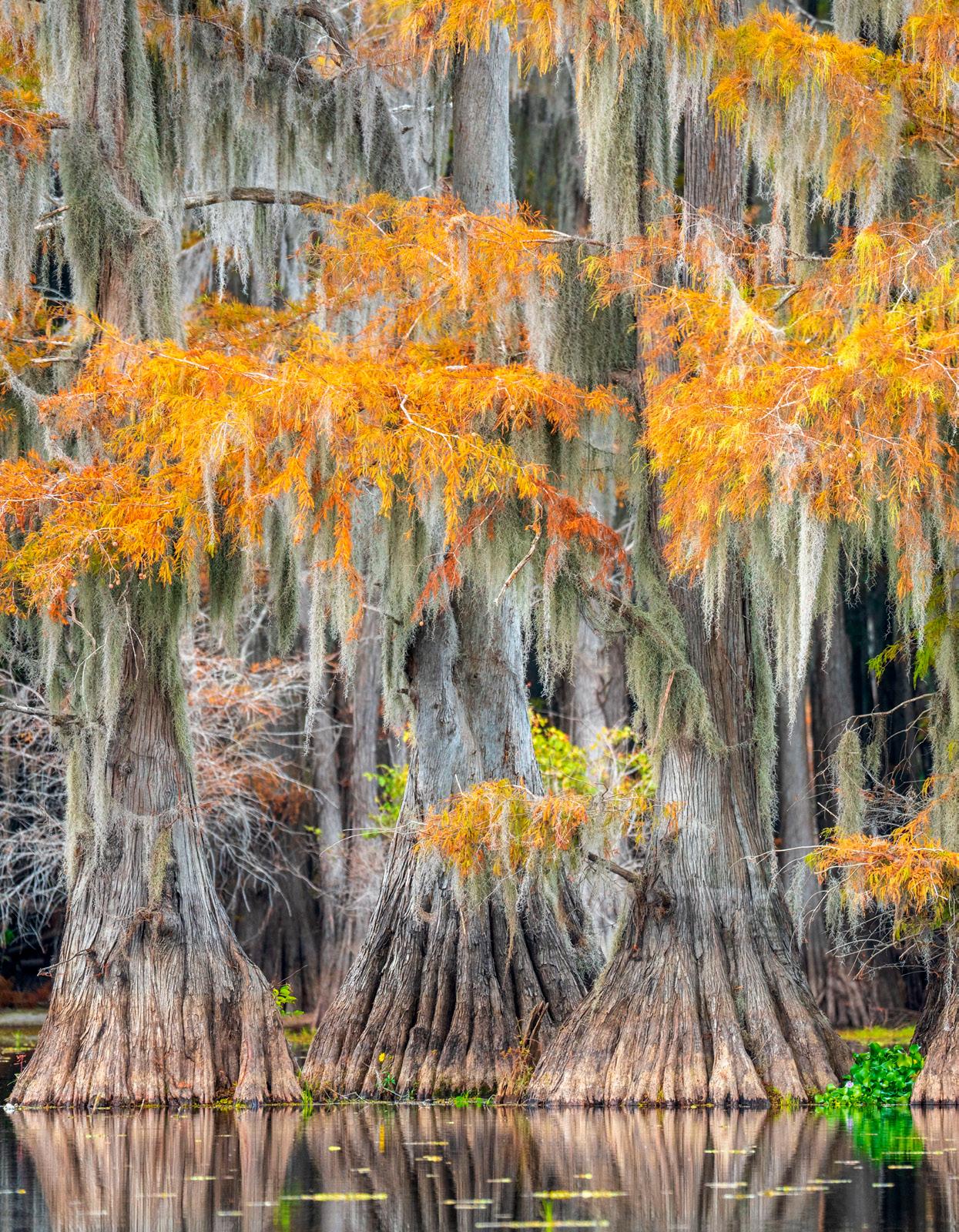
PHOTOS: IAN PLANT EXCURSION 32 Tamron Magazine
Straddled across the Texas and Louisiana border lies Caddo Lake, an internationally protected wetland that includes one of the largest flooded cypress forests on Earth. That’s where Ian Plant spends time in the autumn exploring with a trio of Tamron lenses: the 17-28mm F/2.8 Di III RXD ultra-wide-angle zoom, the 28-75mm F/2.8 Di III VXD G2, and the 150-500mm Di III VC VXD ultratelephoto zoom.

“The cypress swamp is one of the most hauntingly beautiful places on Earth,” Ian says. “A lot of times you’re out there and there’s no one else around. You feel very removed from the rest of civilization, with all the Spanish moss hanging off the trees like tinsel and fluttering in the breeze, which creates a very moody, ethereal vibe.”
Trying to capture that feeling is what can make photographing the cypress swamp challenging but also unique, and Ian’s Tamron lenses help him achieve this task. “My two longer lenses are ideal for Caddo Lake, because you want to be able to zoom in on the details and color of the fall foliage, and on the reflections in the water, without having any distracting sky in the background,” he says. “However, the 1728mm comes in handy when there happens to be a spectacular sunrise or sunset. That’s the one situation when I do want the sky incorporated into the photo, and so a wider lens that can capture a larger expanse is perfect in those cases.”
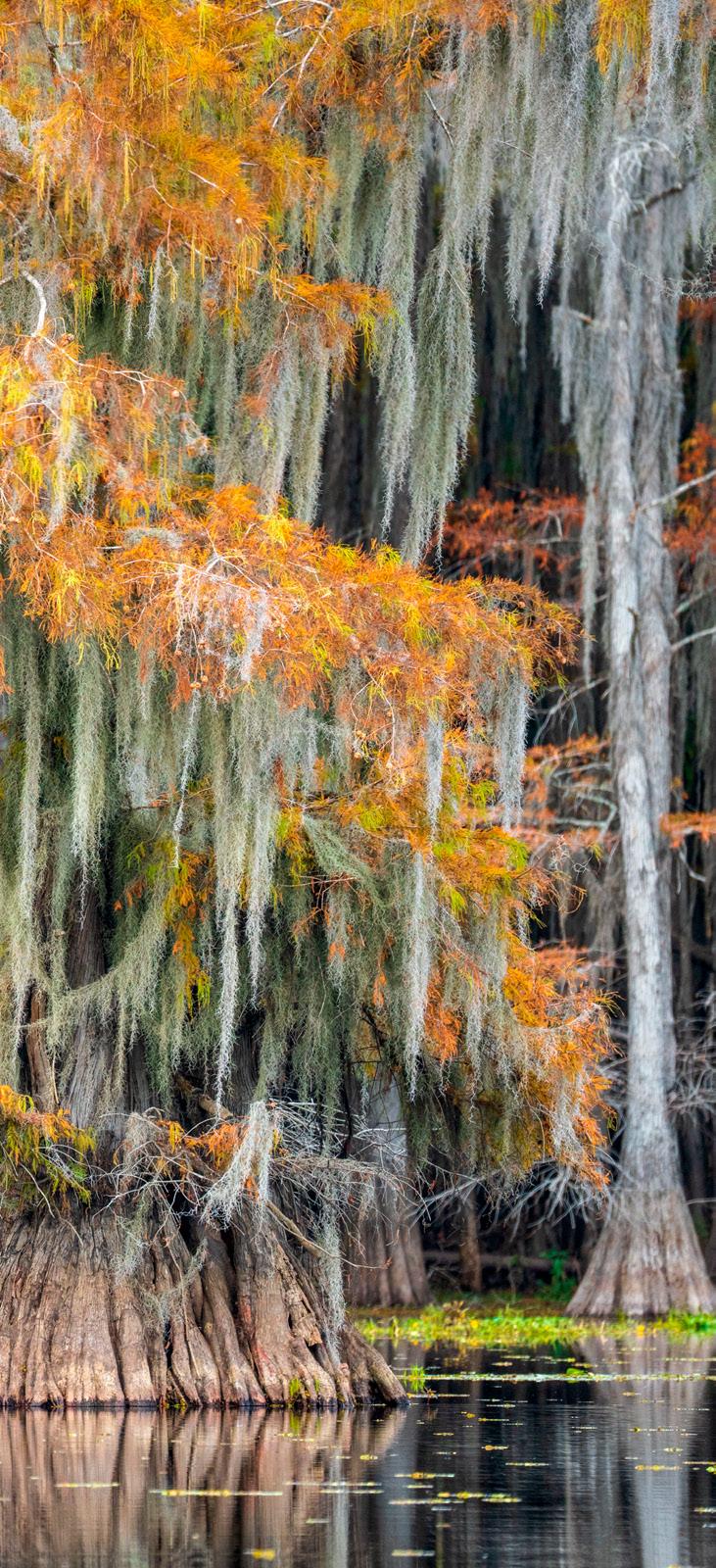
EXCURSION
150-500mm (329mm), F/5.6, 1/250 sec., ISO 500
Tamron Magazine 33
150-500mm (201mm), F/5, 1/200 sec., ISO 640
Ian takes his workshop students out in Zodiacs, rigid inflatables that offer stability and easy access to some of the more remote parts of the swamp. “It’s a motorboat, so we’re able to get around quickly,” he says. “And that speed is key. If it suddenly looks like it’s going to be a gorgeous sunset and you’re in the wrong place for that, it could take two hours to make it over to open water for better photo opps.”
The Zodiac is also a small vessel with a shallow draft, so Ian’s group can access areas where typically only visitors with canoes or kayaks can go. “We’ll see other photo tours in large metal pontoon boats, and they’re slower and can’t get into the same spots we do,”
he says. “Plus, the Zodiacs offer great stability, and it’s very easy to get low to the water, which opens up more creative opportunities in terms of capturing reflections and foreground elements like lily pads.”
Those reflections of the vibrant fall colors are the money shots at this time of year. “The lake is, for the most part, pretty well protected from the wind, so even if it is windy out, you won’t get too much chop on the lake, allowing for a smooth surface on the water that’s ideal for reflections,” Ian says. “Even if you do get a little bit of a ripple, either from the wind or your boat, you can sometimes parlay that into creating a
150-500mm (150mm), F/5, 1/200 sec., ISO 2500
28-75mm (43mm), F/16, 1/100 sec., ISO 3200
reflection with an impressionistic blur, which can be quite nice.”
If you’re dealing with overcast conditions, then you can easily shoot in the bayou all day. “Having a little bit of fog helps diffuse the light as well,” Ian says. Otherwise, he tries to head out during the golden hour to maximize the colors he can capture and so he can find ways to use the lighting to show off his subjects.

“I’m always looking to cut through the chaos, either by looking for a tree that’s standing out from the shoreline, or via an appealing lighting situation,” he says. “An hour before the sun sets can be a terrific time to take pictures— the sidelighting or backlighting on the Spanish moss in the trees can be breathtaking. Even better is if you can find a dark background to photograph your subject against. That will really help bring order to the image and offer a unified composition for the viewer.”
Foreground elements, like a mass of bright green lily pads, also can offer a colorful contrast to the cypresses. “That’s another situation in which I’d use a wider lens like the 17-28mm, because I can aim the camera down and incorporate those foreground features into the frame, leading to the background where the cypress trees are waiting,” Ian says.
One particular challenge Ian faces out on the bayou isn’t a photographic one. “I’m very cognizant about not
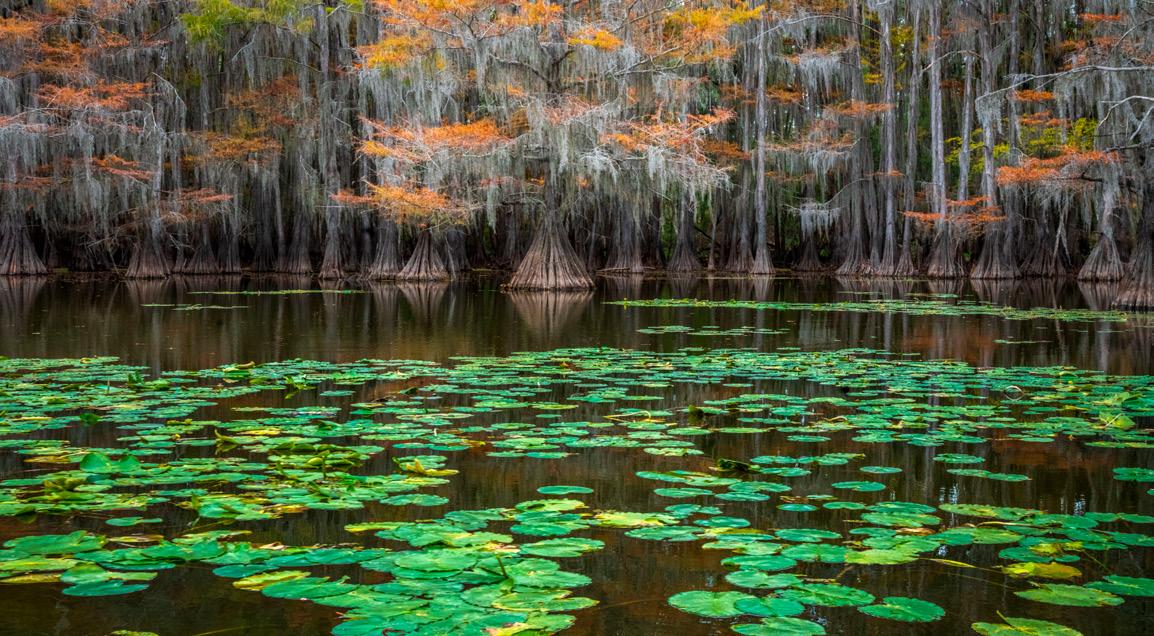
EXCURSION
34 Tamron Magazine
getting lost,” he says. “It can become a bewildering maze out there, so I have GPS enabled on my phone at all times. It’s especially important if you’ve been shooting at sunset and need to navigate back to the boat launch after the light’s gone. You wouldn’t want to ruin a perfect photo session by getting stuck in the dark.”
Ian is heading back to Caddo Lake this fall, and he hopes to capture what many call the “holy grail” of cypress swamp photography: taking pictures of the swamp during a morning fog. “You want just enough fog so that it adds to that ethereal mood I mentioned, but not enough so that it’s blocking the trees from sight,” he says. “I missed that sweet spot the last time I visited. Maybe this time around I’ll get my lucky break—I’ll have my Tamron lenses with me so I won’t miss it!”
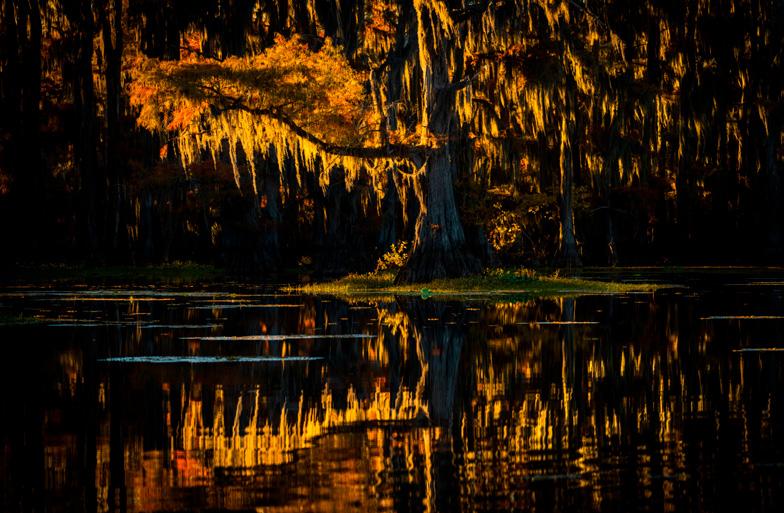
ABOUT: IAN PLANT

World-renowned professional photogra pher Ian Plant travels the globe seeking out amazing places and subjects in his never-ending quest to capture the beauty of our world with his camera. Ian is a frequent contribu tor to many leading photo maga zines, the author of numerous books and instructional videos, and founder of Photo Masters (www. photomasters.com), a site dedi cated to photography education and inspiration.

Instagram: @ianplantphoto

IAN PLANT EXCURSION
PHOTOS:
Tamron Magazine 35 150-500mm Di III VC VXD [model A057] 17-28mm F/2.8 Di III RXD [model A046] 28-75mm F/2.8 Di III VXD G2 [model A063]
“AN HOUR BEFORE THE SUN SETS CAN BE A TERRIFIC TIME TO TAKE PICTURES— THE SIDELIGHTING OR BACKLIGHTING ON THE SPANISH MOSS IN THE TREES CAN BE BREATHTAKING.”
17-28mm (17mm), F/3.2, 1/50 sec., ISO 100 150-500mm (150mm), F/5.6, 1/250 sec., ISO 250
A FAMILY AFFAIR
In Marcie Reif’s group portraits with the Tamron 20-40mm F2.8 zoom, every person has a job.

PRACTICE 36 Tamron Magazine
PHOTO: MARCIE REIF
40mm, F/2.8, 1/640 sec., ISO 400
When Marcie Reif holds photo sessions with her clients, one of the most important factors for her in making those sessions a success are up-close interactions to elicit high-emotion images. “I want my subjects’ personalities to shine,” she says.
The Atlanta photographer was recently able to test-drive the new Tamron 20-40mm F/2.8 Di III VXD zoom lens during some family portraits, and she’s so far been impressed with the results. “I’ve photographed a half-dozen families using that lens, and it fits my style perfectly,” she says. “My preferred focal length is 35mm, so the 20-40mm hits that sweet spot, allowing me to stay within that range and achieve fun, playful shots on the wider end, like when the parents swing the kids toward me while goofing around.”
Marcie appreciates the 20-40mm’s light weight and compact size, as her photo sessions with families tend to be on the lively side. “I’m already expending a lot of energy in working with the kids,” she says. “The less weight pulling me down, the better. Being able to shoot wide open with that maximum F/2.8 aperture is also critical to my style. All the Tamron lenses I’ve used have been incredible, and this newest addition fits right in.”
PHOTO TIPS: FAMILY PORTRAITS

1 Shoot wide open. Take advantage of the 20-40mm’s maximum F/2.8 aperture. It allows you to isolate your subjects from whatever background you’re shooting against and makes them pop in the photo.
2 Pinpoint the lighting effect you’re after. For family portraits, it’s important to have the light right on my subjects when possible, for good color and skin tones. For some of the photos in these recent sessions with the 2040mm, I had the families walk along a path, with the light directly in front of them. The background is shaded, and the big, bright sky helped to bounce the light onto my subjects, though it was filtered through the trees so it wasn’t too harsh.
Sometimes, though, I’ll go for the backlight effect. Photographers often talk about how it’s ideal to shoot in the golden hour, but if you start shooting a full hour before sunset, the light may still be kind of strong and white. Wait another 30 minutes and you’ll have that warmer, softer light that’s a little easier to work with at your disposal.
PRACTICE
Tamron Magazine 37
3 Angle yourself to eliminate distractions. Although I usually try to be at eye level with my subjects, especially with the younger ones, sometimes I’ll shoot down on them in certain situations. In the photo here of the girl with the hat, there was a big white sky behind her that would’ve just become blown out if it had been included in the frame. The viewer’s eye would’ve gone directly to the brightest part of the image, which would take away from my subject’s cute little face. That’s also why I try to focus as much as I can on the eyes and isolate them so that the background becomes secondary.
4 When photographing larger families, give each person a job.
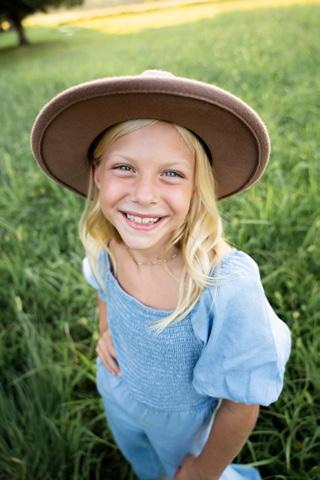



Taking pictures of bigger groups means you’re going to have more balls in the air, so I’ll talk to each person individually before I start taking pictures. I’ll have the parents hold or otherwise wrangle with the babies and toddlers, while I’ll instruct the older children on what I want them doing in the pictures. I’ll tell them that I’m going to have to concentrate on getting their little brother or sister to smile, and so could they keep smiling at me to help me out? When they feel like they’re taking more of a leadership role, they’re more apt to go along with everything. You’ve got to make it a team effort and ensure everyone feels like they’re playing an important part in creating the image.
5 Figure out a way to keep younger subjects within the frame. It’s usually pretty easy to hold a baby in your lap. Toddlers and preschoolers, however, don’t always want to be held, or to stay in one place for too long. So I’m always looking for ways to set up a photo so that the way we’re keeping their movements restricted to a certain space simply looks like they’re having fun with Mom and Dad. That could mean one of the parents holding them, but not in a static way—maybe picking them up and veering them toward the camera, or making them
PRACTICE
“I TRY TO FOCUS AS MUCH AS I CAN ON THE EYES AND ISOLATE THEM SO THAT THE BACKGROUND BECOMES SECONDARY.”
40mm, F/2.8, 1/800 sec., ISO 400 28mm, F/2.8, 1/1250 sec., ISO 800 29mm, F/2.8, 1/640 sec., ISO 800 38 Tamron Magazine 21mm, F/2.8, 1/500 sec., ISO 400
20mm, F/2.8, 1/640 sec., ISO 400
laugh by lifting them up in the air. Or you could position a toddler in the middle of their parents, holding onto Mom and Dad’s hands, maybe doing a few fun swings before I grab a photo or two.
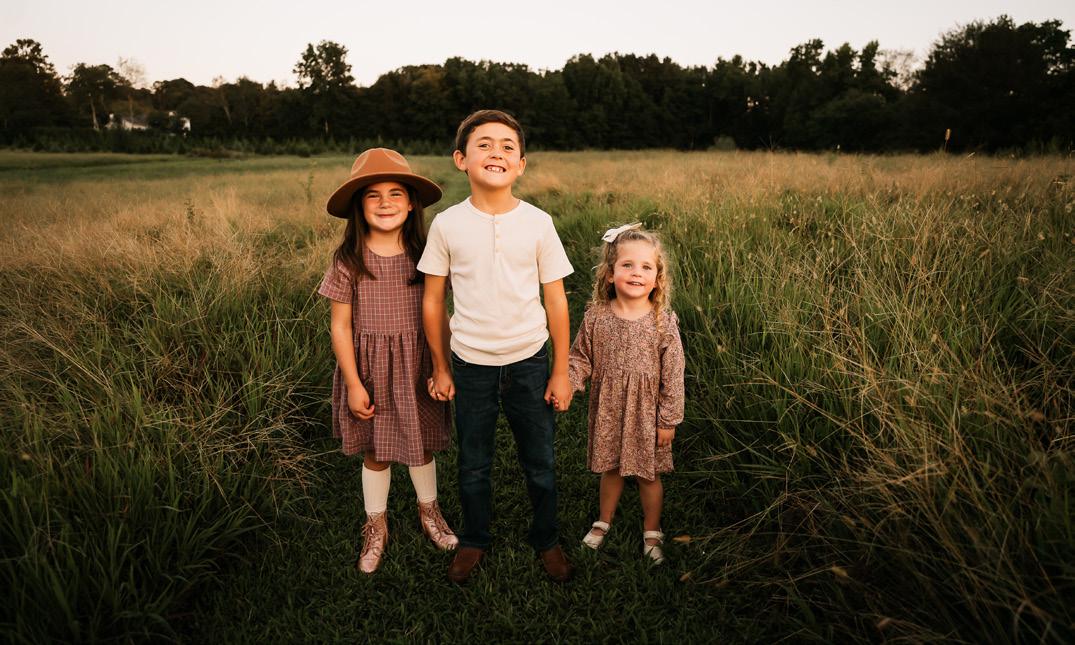
6 Use ample praise with all of the children. No matter what age your younger subjects are, I’m constantly complimenting them. Most kids aim to please, especially if they hear me, an adult, telling other children what a great job they’re doing. They want to get that same compliment out of me. I’ll even sense sometimes that one child is a little jealous of another receiving more attention. If I pick up on that, I’ll switch my attention to them, and before you know it, they’re eagerly participating in the photo. So much of this type of photo shoot is just knowing how to talk to kids and get them to respond to you.
7 Pay attention to clothing. I've placed a much bigger focus this year on helping to style my clients for their photos. I realized that giving them some
guidance and direction really elevated the images. I either send them a color palette to work from or a website to help them style their own outfits, or they can choose clothes from the client closet.
In general, you want colors that go together well, none of them too bright or too dark, and that complement each other, their hair color, and their skin tone.
ABOUT: MARCIE REIF

NEW 20-40mm F/2.8 Di III VXD
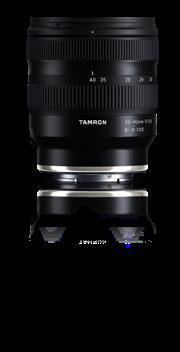
Model A062
Focal Length 20-40
Max. Aperture F/2.8
Blades 9 (circular diaphragm)
MOD 6.7” (WIDE) 11.4” (TELE)
Max. Mag. Ratio 1:3.8 (WIDE) 1:5.1 (TELE)
Length 3.4”
Weight 12.9 oz. Filter Size Ø67mm Max. Diameter Ø74.4mm Mount Sony E-Mount
Marcie Reif is an in-demand kids, family, and commer cial photographer in Atlanta, GA. In addition to running her portrait business she is also a photography educator. Marcie is the co-founder of The Photogra pher’s Retreat, an educational experience for female photog raphers, and the author of the best selling instructional resource Bringing Home the Story of the Beach.
Instagram: @marcie_reif_photography
PRACTICE
PHOTOS: MARCIE REIF
“YOU’VE GOT TO MAKE IT A TEAM EFFORT AND ENSURE EVERYONE FEELS LIKE THEY’RE PLAYING AN IMPORTANT PART IN CREATING THE IMAGE.”
Tamron Magazine 39
PASSION PROJECTS
Julien Jarry uses his trio of Tamron lenses to communicate a message and evoke emotion.
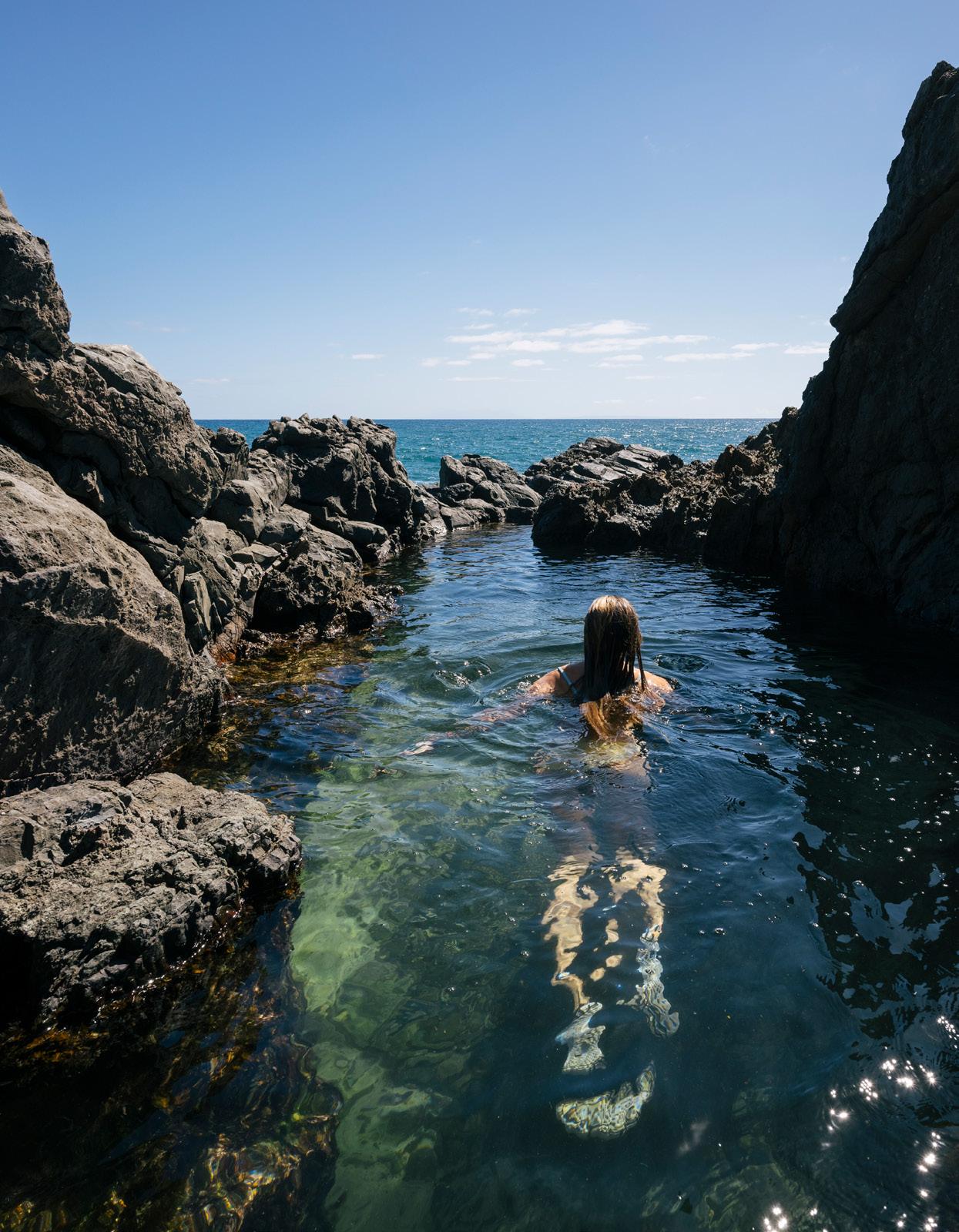
PHOTOS: JULIEN JARRY
FIELD REPORT 40 Tamron Magazine
17-28mm (17mm), F/11, 1/320 sec., ISO 12800
On Julien Jarry’s website (julienjarry. com), one succinct line spells out his creative mission: “communicating a message, casting a vision, and telling a story in order to accomplish goals such as raising money, awareness, and/or marketing a product or strategy.” It’s a goal the Con necticut photographer and cinematographer takes seriously. “That’s not random gibberish,” he says. “I thought carefully about what it is that we do, and that’s exactly what we do.”
We caught up with Julien to talk about how he conveys those messages; his cre ative collaboration with his wife, Kelly; and how Tamron’s lenses fit into the big picture, including in a recent landscape film he shot in Hawaii.
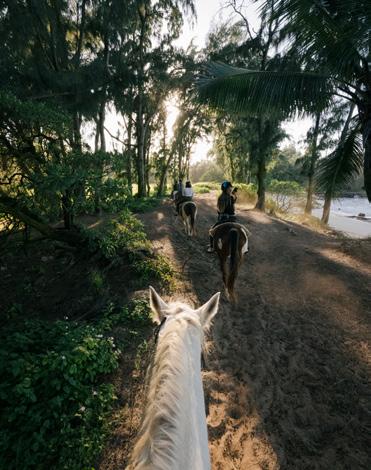

Tell us how you found your way into photography and videography.
Julien Jarry: When I was in college, my mom bought me a point-and-shoot camera. When I graduated college, I upgraded to a Lumix, then to an even better camera, and I became completely obsessed. It was all photography for me for the next few years; I was superhungry to learn all I could. Eventually I turned to video as well.
What’s funny is that both of my parents were artists, and my father was a photographer— yet I wasn’t really in touch with that when I was a kid. Once I became hooked on creating images, I shared that with my father, and he was able to offer constructive criticism that helped me learn even more.
FIELD REPORT
17-28mm (17mm), F/8, 1/400 sec., ISO 100 Tamron Magazine 41
How did your work evolve from there?
Julien Jarry: During the time I was discovering photography, I was volunteering with my church. We traveled as a group to Jamaica for three years straight, and I developed into a documentary photographer and filmmaker. Then I ended up opening up a restaurant and taking pictures of food. Three years into that, I decided I wanted to jump more fully into photography and video.
I served as my church’s creative director for seven years. To supplement my
income that first year, I started doing real-estate photography of high-end homes here in Connecticut, which then segued into local promotional work, nonprofit projects, and the like. Today, my company shoots everything from local and national commercials to documentaries that tell a story or raise funds, and I’m gearing up to shoot my first short film. I think I’ve been able to find success because I’ve been so passionate that it’s contagious. I’m always excited about what I do, and maybe people are drawn to that.
Tell us about your day-to-day, and what you especially like to shoot.
Julien Jarry: There’s a lot of variety in my work—which means every day is a new day. Creating commercials is cool, but documentaries are my favorite to create. When I’ve looked back to see what my passion projects have been, it’s typically micro-documentaries. Looking ahead, I’d like to break more into narrative films.
Talk about the most recent landscape film you shot in Hawaii.
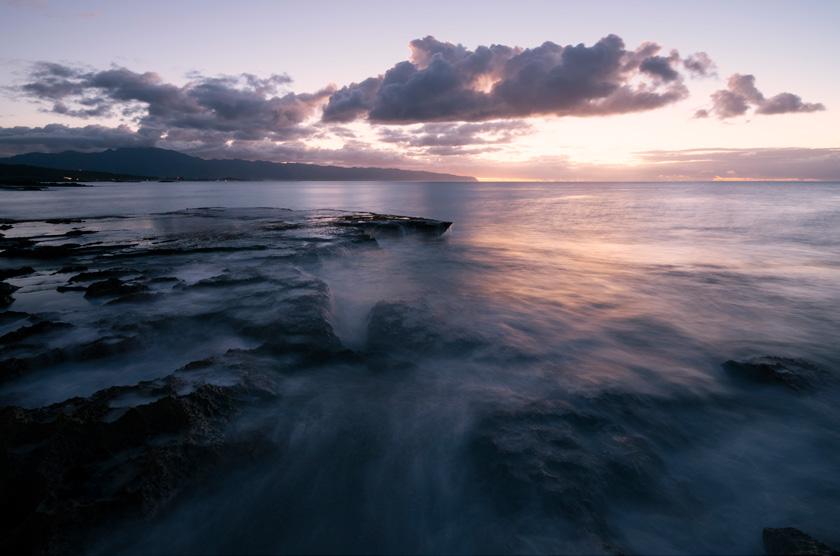
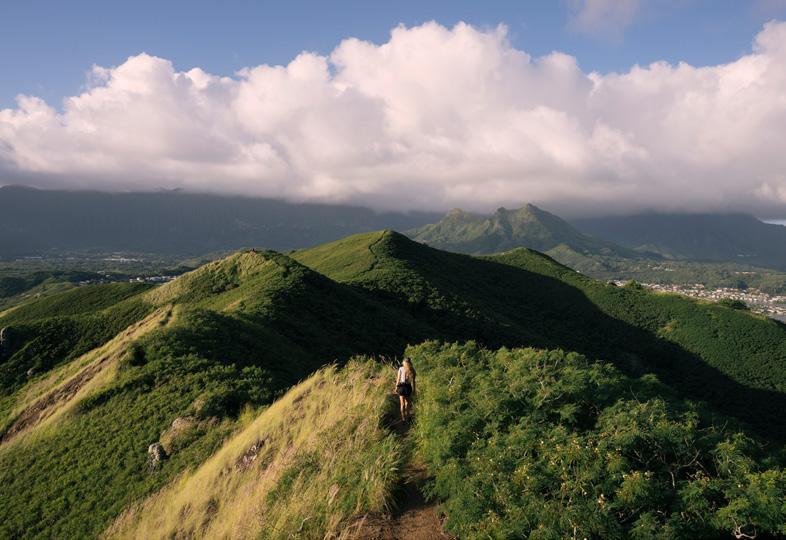
Julien Jarry: The Hawaii film fits in with another film I recently did, and a third one I’m set to do soon. During COVID lockdown, my wife and I bought an RV and headed out west, and we ended up shooting a bunch of landscapes and turning it into a short film, Nahasdzáán, recently screened at the National Museum of the American Indian’s “Native Cinema Showcase” and even at a TED Talk recently in New York. The film is a narrated original Indigenous poem laid over video of Southwest landscapes. We came away with some beautiful images that really communicate a message and evoke an emotion. That’s what I wanted to do in Oahu as well. I work closely with an Indigenousbased production company, Tse’Nato’, and I wanted to shoot a similar landscape film in that niche. The land’s history is so rich, and I knew I could find meaningful
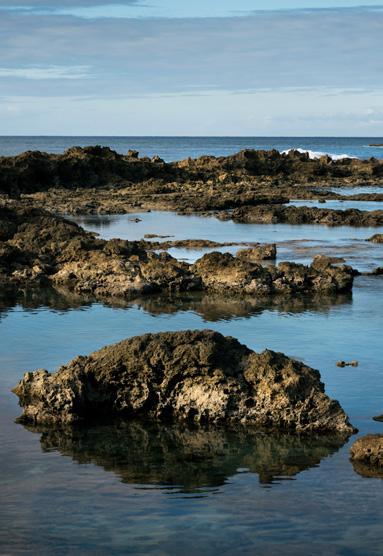
"PHOTOGRAPHERS ARE DRIVEN TO MAKE
SATISFACTION FROM THE PROCESS.” 17-28mm (24mm), F/10, 1/100 sec., ISO 100 FIELD REPORT
F/11, 1/200 sec., ISO 160 17-28mm (17mm), F/9, 6.0 sec., ISO 100 42 Tamron Magazine
IMAGES—WE DERIVE
35-150mm (87mm),
messages there, too. We’re also going to Peru soon for an Indigenous-based documentary about food, using the same Tamron lenses I used in Hawaii.
How did Tamron’s lenses come into play there?
Julien Jarry: Because we were on vacation, I knew I didn’t want to take my larger Sony cinema camera. Instead, I packed the smaller A1, with three Tamron lenses: the Tamron 17-28mm F/2.8 Di III RXD, the 35-150mm F/2-2.8 Di III VXD, and the 150-500mm Di III VC VXD.

Even within the last five or 10 years, you’d often have to buy the on-brand lenses to achieve optimal image quality. That’s not the case anymore—these Tamron lenses in my gear bag are as good as anything out there, if not better. My images are tack-sharp, and it’s amazing for me to be able to head out on a big trip like this with three lenses that offer me a focal-length range from 17mm to 500mm.
My wife and I spent the trip switching off between lenses. I brought the 150500mm to photograph wildlife, or if I wanted to zoom in on surfers or the mountains. I love shooting landscapes with ultratelephoto lenses. The 17-28mm offered a wider view when I needed it, and the 35-150mm was the “everything” lens.
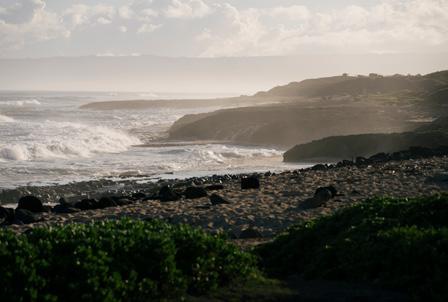
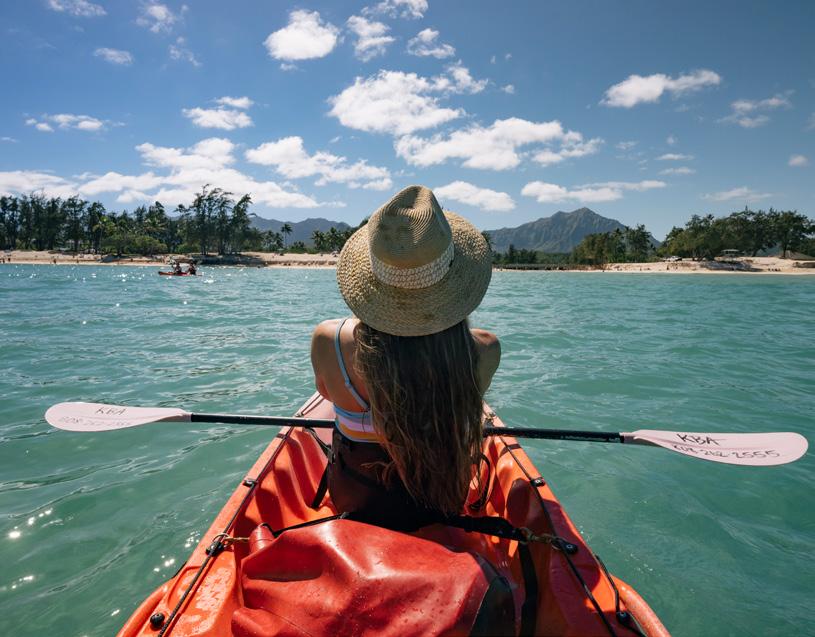
Tell us more about your collaboration with your wife.
Julien Jarry: It’s great having someone so close who appreciates the craft. Kelly works with me on every set, whether she’s the assistant cameraperson or camera operator or shooting behind-thescenes images.
The 35-150 has become Kelly’s favorite all-around lens. She brings it every week to church, using it in the church lobby to document people chatting, then zooming in to capture people singing on the stage. In Hawaii, while I was shooting video, she took pictures of local architecture or went on hikes to take photos of landscapes and sunsets.
What’s the most challenging aspect of your work?
Julien Jarry: When I’m not shooting. I know some people really get into the preproduction process, but for me, if it starts to drag on, it becomes almost like the homework you don’t want to do.

What’s the most satisfying part of your work?
Julien Jarry: To repeat that exact word: being satisfied with the result, whether it’s for a client or creating a piece of art for myself. Photographers are driven to make images—we derive satisfaction from the process. I’m not sure if it’s a chemical thing or not, but finding that beauty in images does something to my mind. It makes me happy.
150-500mm F/5-6.7 Di III VC VXD [model A057]
35-150mm F/2-2.8 Di III VXD [model A058]
17-28mm F/2.8 Di III RXD [model A046]
Julien and his wife, Kelly, are self-taught photographers turned filmmakers. They specialize in documentaries and commercials focused around, but not limited to, communicating a message, casting a vision, and telling a story in order to accom plish goals such as raising money, awareness, and/or marketing a product or strategy. They reside in Connecticut, just outside of New York City, and love traveling and creating.
Instagram: @julienajarry
PHOTOS: JULIEN JARRY
FIELD REPORT 17-28mm
F/10,
(17mm),
1/250 sec., ISO 400
35-150mm (150mm), F/5.0, 1/500 sec., ISO 100
ABOUT: JULIEN JARRY
Tamron Magazine 43
MY PROJECT ON THE GO IN SPAIN AND GREECE
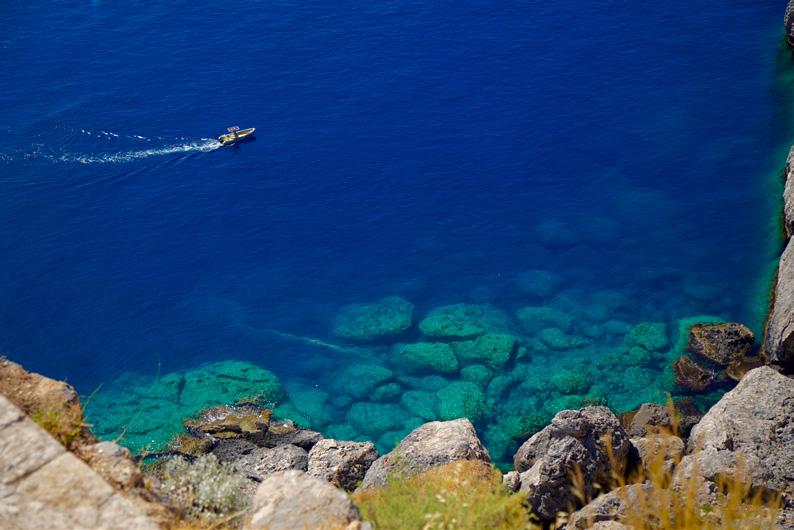
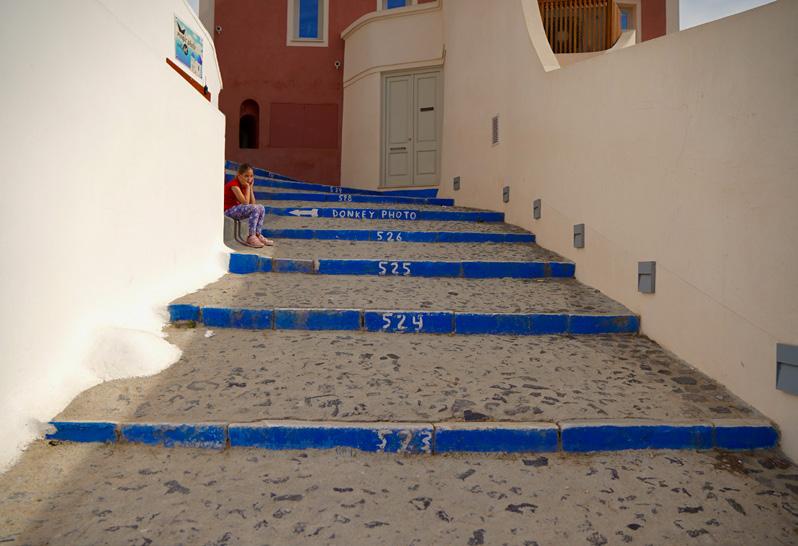
Recent graduate Noah Bullock uses the lightweight Tamron 17-70mm F/2.8 VC

lens to capture European art and culture.
Once I graduated from Iowa’s University of Dubuque, I became the coordinator for the college’s Bisignano Art Gallery, where I’d been employed as a work-study student. I coordinate all of our monthly shows, and I also serve as the administrator of the university’s photo club. In addition, I help out with the school’s international trips, which are typically focused on art, culture, and the like.
A new lens that has found its way into my gear bag is the versatile Tamron 17-70mm F2.8 VC zoom. You can capture landscapes with the wide end, then zoom in to capture details and people on the street. Plus this lens is so lightweight and compact. It’s great to not have to carry multiple lenses when I’m traveling overseas.
I recently took two trips with the students where I used the 17-70mm: the city of Toledo in Spain, and Greece. Toledo is a beautiful walled-in city that served as one of the nation’s oldest fortresses. The streets are very narrow, with lots of twists, turns, and tiny shops. Because the Toledo trip was an art-centered one, the colors of these vibrant vintage prints drew me in to capture the scene.
When I’m traveling, I love to take photos of buskers and other random people on the street. What I appreciate most about using the 17-70 in those situations is that I can be right in front of my subjects’ faces, interacting with them, like I was with the Greek man shown here playing a traditional lute. Or, I can have the option to be invisible, which
17mm, F/2.8, 1/2500 sec., ISO 160
37mm, F/2.8, 1/2500 sec., ISO 160
44 Tamron Magazine
allows me to stand back a bit and quietly zoom in without disturbing my subject.
That was the case with this woman creating a rug in Turkey, which we visited while in Greece. These women train for decades to become masters of this craft—it can take up to six months to weave an intricately designed rug. I didn’t want to bother this rug maker while she was working. Instead, I stood a couple of feet back and captured her “game face,” which showed how hard she was concentrating.
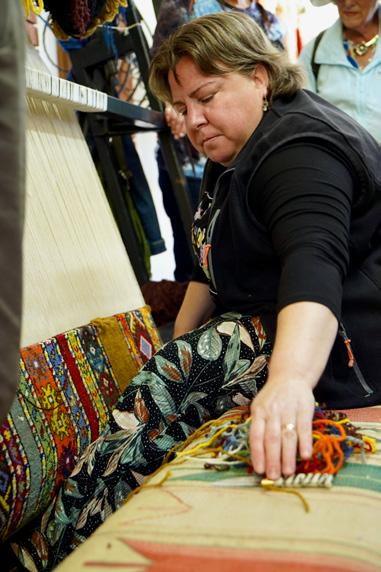
Meanwhile, on the island of Santorini, there are three ways to make your way up to the main part of the city: You can take a cable car, walk up hundreds of zigzagging stone steps, or ride a donkey to the top of the steps. They usually have two or three of the donkeys tethered together, so when I was riding up, I leaned back on the donkey I was riding, zoomed out to 17mm, and captured this photo of one of the other donkeys. When I was almost to the top of the stairs on the donkey’s journey, I noticed this little girl sitting off to the side. I couldn’t tell if she was sad, bored, or just daydreaming. The more I watched her, the more I realized she was simply people-watching. It felt like another interesting, unobtrusive image to capture with my 17-70.
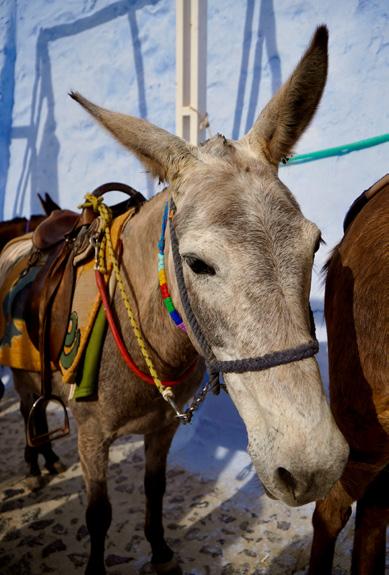
This lens was also great for taking wider photos of the landscapes I experienced in Greece, like this final shot I took from the Acropolis of Rhodes, overlooking St. Paul’s Bay. It’s the cove where the Apostle Paul landed centuries ago. I was amazed at the blues and greens of the water. I got lucky when that boat came through right as I was taking the picture. I was able to zoom in on that with this lens, adding a sense of scale to the scene.
PROFILE: NOAH H. F. BULLOCK
Location: Dubuque, IA
Occupation: Coordinator, Bisignano Art Gallery University of Dubuque
Photographic Specialty: Travel & Sports

Passions: International Travel, Surfing & Camping
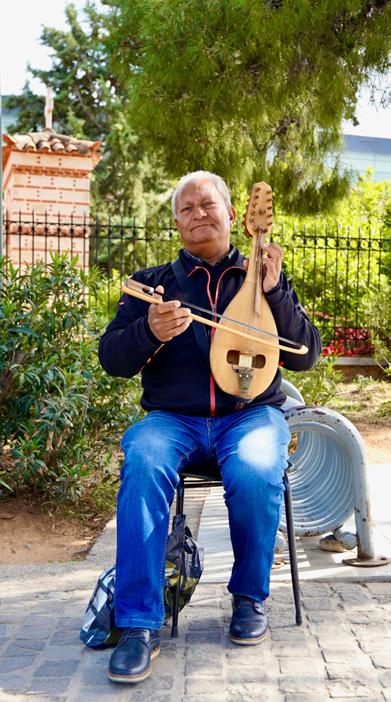
Favorite Lenses: 17-70mm F/2.8, 18-300mm F/3.5-6.3, 11-20mm F/2.8, 150-600mm F/5-6.3
Instagram: @noah.bullockphoto_
Tamron Magazine 45 MY PROJECT
45mm, F/3.5, 1/80 sec., ISO 200
sec.,
1000 28mm, F/2.8, 1/60 sec., ISO 160 17mm,
1/4000
160
34mm, F/2.8, 1/60
ISO
F/2.8,
sec., ISO
PARTING SHOT:
50-400mm (75mm), F/5.6, 1/500 sec.,
Fox Against the Blue Sky
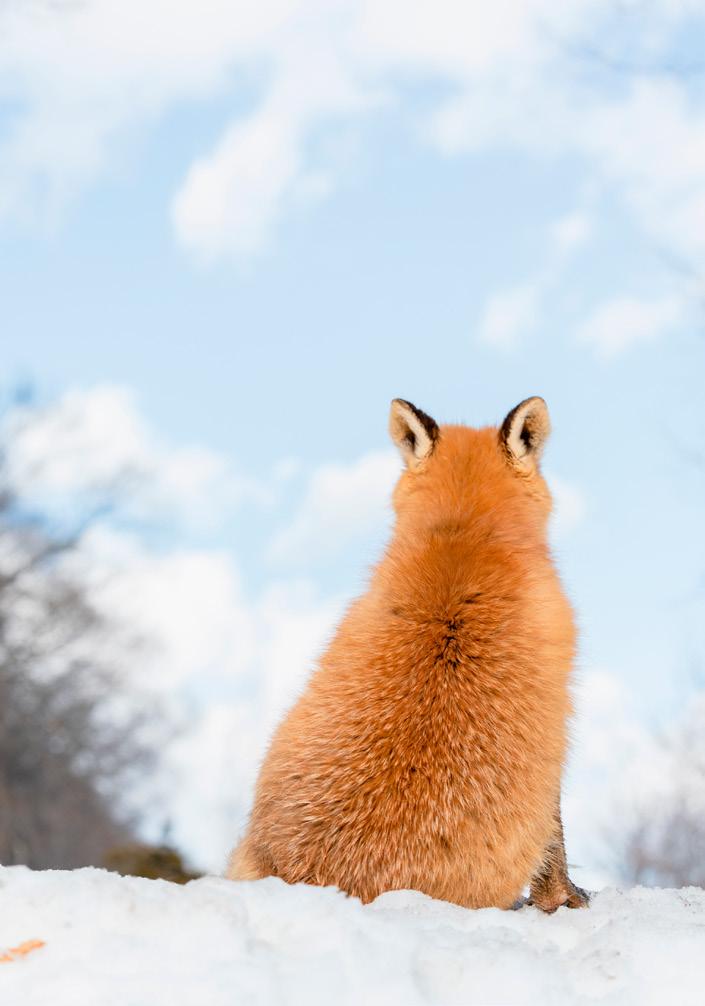
Many recent zoos are designed so that the animals on display can live in a more relaxed environment, and that makes the 50-400mm focus length range very handy. I was able to take photos with a composition like this fox at the Kitakitsune Farm in Hokkaido, Japan, where the animals are free to relax in vast grounds and you can photograph them without worrying about fences or cages. Captured with my Tamron 50-400mm F/4.5-6.3 Di III VC VXD (Model A067): 75mm 1/500 F5.6 ISO 200 ©Masaki Kadono Instagram: @chawan_photography
MAGAZINE FEEDBACK
tamroneditor@tamron.com #tamronusamagazine
CUSTOMER SERVICE
If you have any questions about our products or services, get in contact with us: Telephone: 1-800-827-8880 / prompt 1 Email: custserv@tamron.com Mon-Fri 8:45am – 5:00pm EST
REPAIRS
Tamron products are manufactured with the greatest care and precision. However, should there be any damage to your lens, Tamron Customer Service will be happy to assist you. All Tamron lenses purchased through an authorized Tamron Americas retailer are supported with our 6-Year Warranty. You can find contact addresses and more detailed information on the warranty and the procedure for sending in the product and having it repaired in the Support section of our website: www.tamron-americas.com
46 Tamron Magazine
CONTACT
Publisher: Tamron Americas, 10 Austin Blvd, Commack, NY 11725 Editor: Stacie Errera Writer: Jennifer Gidman Staff: Sabrina Retas, Lisa Keller, Damion Fearron Contributors: Ken Hubbard Production and layout: Stephen Reisig / Real Imagination Printed by: Spectragraphic, New England Reprinting, reproduction in online services and on the internet, duplication onto storage media such as thumbdrive, CD-ROM, DVD-ROM etc. are only permitted with the advance written permission of the editorial staff. All information, prices, dimensions and colors are subject to correction
© 2022, Tamron Americas
LEGAL NOTICE
Copyright
ISO 200
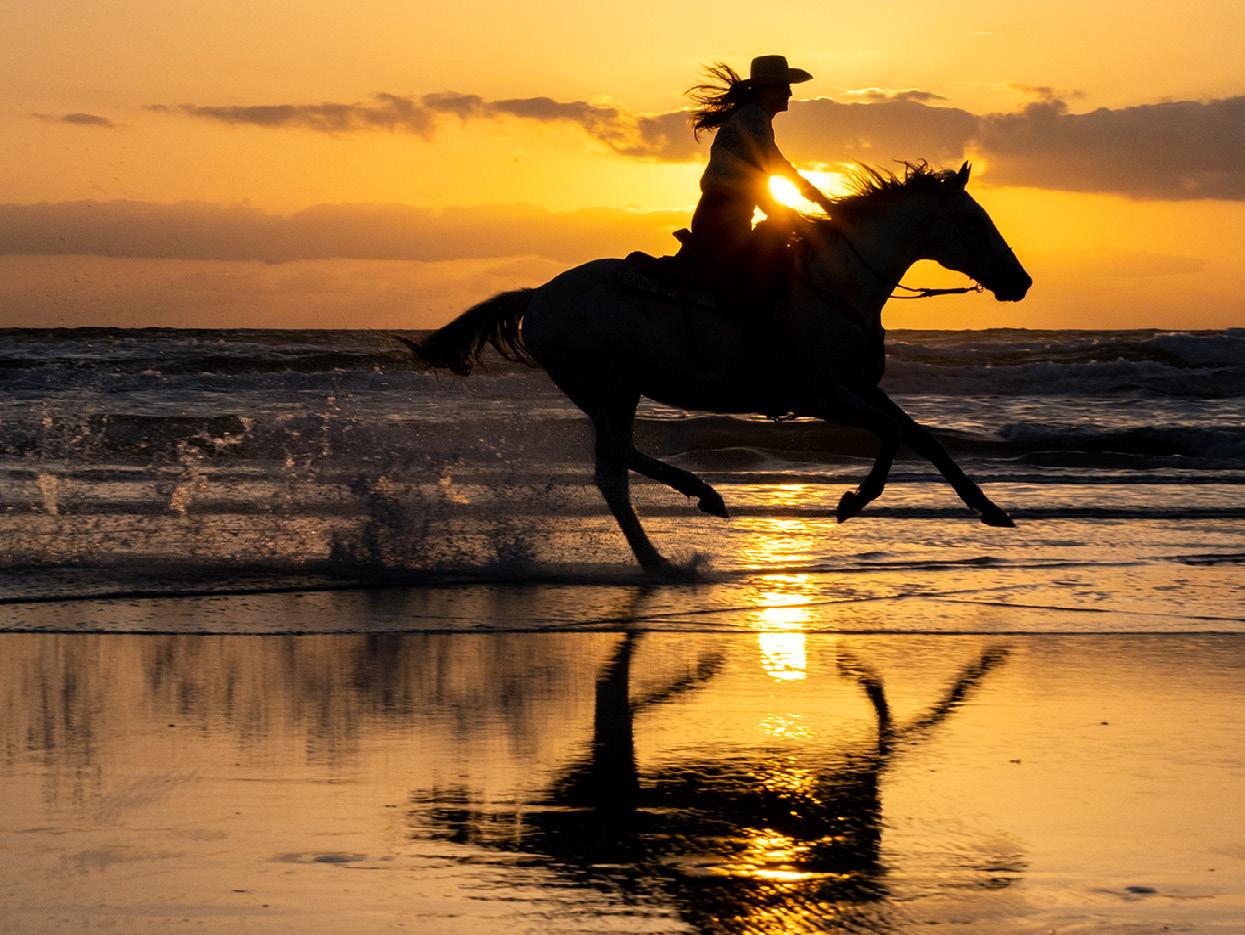
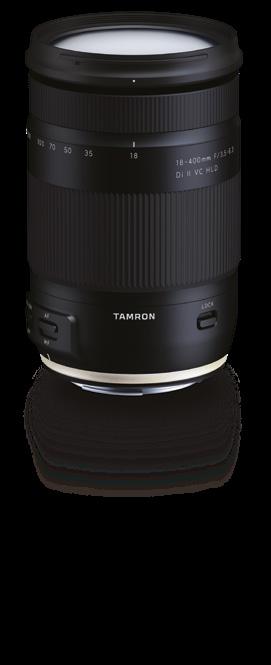

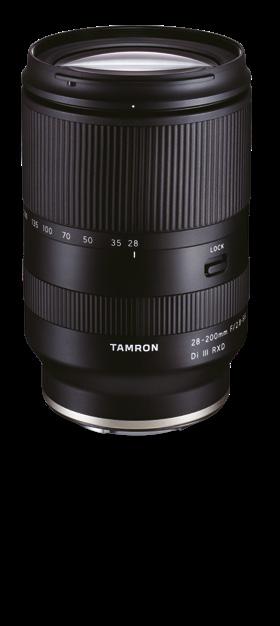
ONLY AVAILABLE AT YOUR AUTHORIZED TAMRON AMERICAS RETAILER www.tamron-americas.com Choose the perfect Travel Zoom for your next photo excursion APS-C MIRRORLESS FULLFRAME MIRRORLESS APS-C DSLR ALL-IN-ONE ZOOM LENS For Sony E-Mount [ model A071] 28-200mm F/2.8-5.6 Di III RXD ALL-IN-ONE ZOOM LENS For Sony E-Mount and FUJIFILM X-Mount [ model B061] 18-300mm F/3.5-6.3 Di III-A VC VXD ALL-IN-ONE ZOOM LENS For Canon and Nikon DSLR mount [ model B028] 18-400mm F/3.5-6.3 Di II VC HLD © Ken Hubbard
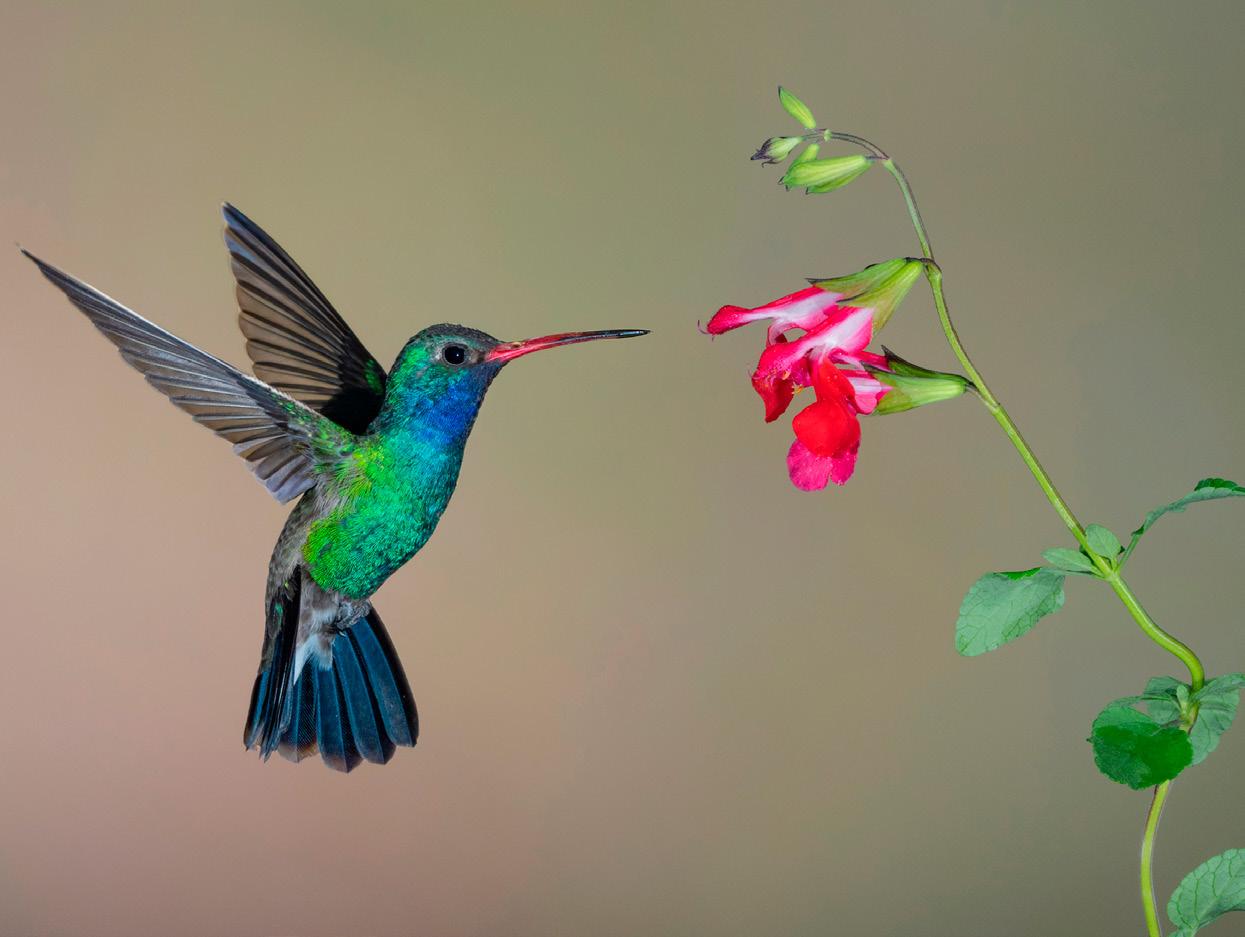
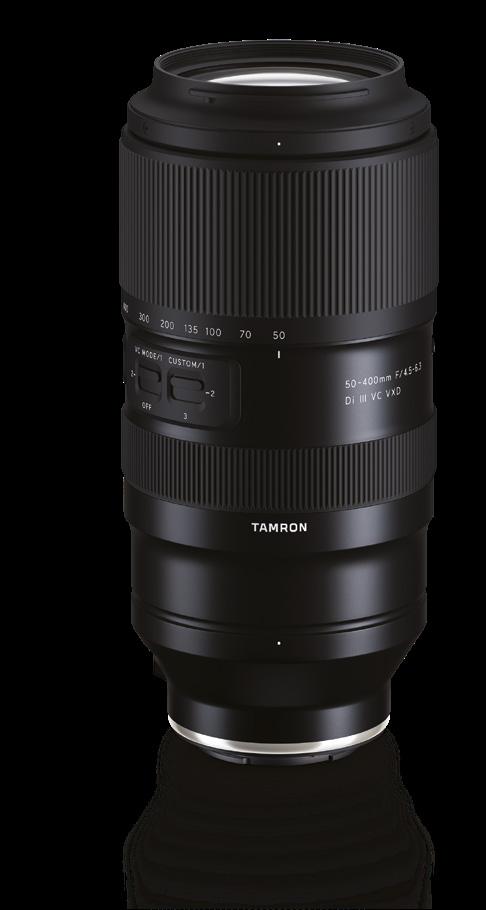
www.tamron-americas.com
Lisa Langell New 8x ultra-telephoto lens zooms from 50mm. ULTRA-TELEPHOTO ZOOM LENS for Sony Full-Frame Mirrorless Cameras [ model A067 ] NEW RANGE50-400mm F/4.5-6.3 Di III VC VXD ONLY AVAILABLE AT YOUR AUTHORIZED TAMRON AMERICAS RETAILER 50-400mm (241mm), F/25, 1/160 sec., ISO 500
©












































 ©
Alyce Bender
©
Alyce Bender





























 PHOTOS: LISA LANGELL
PHOTOS: LISA LANGELL



















































